

































































































































SUNDAY, AUG 3 RD

WATCH FEATURED PROGRAMMING ALL DAY
TISHA B’AV : :
HOLDING ON TO FAITH: LAYERS OF LOSS
NCSY KUMZITZ OF THE WORLD
RECITE A KINNAH FOR A FALLEN SOLDIER AND MORE!
FOR UPDATES AND MORE INFO, SIGN UP AT ou.org/tishabav



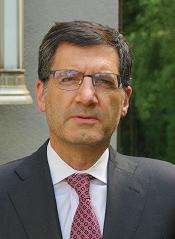

RABBI MOSHE HAUER Executive Vice President, OU
Rav Shlomo Wolbe: A Lifetime Confronting Churban 9:30 AM EDT
RABBI DR. TZVI HERSH WEINREB EVP Emeritus, OU
RABBI STEVEN WEIL CEO, FIDF
The War Against the Jews: The War Against Judaism
9:00 AM EDT
RABBI YAAKOV GLASSER
Managing Director Communal Engagement, OU בל ירובשו תוחול ירבש Shattered Tablets & Broken Hearts Available All Day
Kinnos 5785: Sacrifice & Hope on the Road to Redemption 9:30 AM EDT
I was leaving shul this week, chatting casually with someone about our recent games in a tennis league that benefits a prominent cause. I mentioned how I had lost a playoff match badly, and he seemed surprised – “What happened?” he asked. I shrugged and said, “My back was killing me. I got injured in a previous match.”
A third person walking alongside us gently chimed in. “You know,” he said softly, “you really shouldn’t complain like that... My grandfather just passed away, and he had terrible back pain.”
At first, I wasn’t sure what he meant. Was he saying that my minor injury paled in comparison to what his grandfather endured? Was it a gentle reminder to be more grateful? But then it hit me: this wasn’t about comparison or critique. This was coming from someone who himself lives with some of the most difficult physical challenges I’ve ever seen; countless surgeries, daily limitations, and yet a spirit that somehow shines even brighter because of it. He never complains. He smiles. He jokes. He lifts up those around him. Even when he said this comment about his
grandfather, he was whispering – because his voice is still recovering from a recent surgery. Yet, here I was, complaining about a sore back that just needed a bit of rest.
As we enter the days of Tisha B’Av, I’ve been thinking a lot about how we speak, especially when it comes to bein adam l’chaveiro. We can be close friends, kindhearted people, and still not fully realize how our words land. Sensitivity isn’t about censorship; it’s about awareness. It’s about remembering that we never really know what others are carrying — and certainly when we do know what they’re carrying, we have an even greater responsibility to speak with care and compassion.
And maybe sometimes, the strongest people aren’t the ones winning the match, but the ones walking alongside us, whispering truths with grace and courage.
Wishing you a peaceful Shabbos and an easy fast, Aaron M. Friedman
and mazal tovs to editor@baltimorejewishhome.com
Comfort Year-Round:

Save Big on Energy Costs:
Cut your heating and cooling bills by 30-50% and make your HVAC system work smarter, not harder.
Breathe Better:
Enjoy improved air quality with reduced drafts and outdoor pollutants, creating a healthier living environment.


The 2025 JCSL regular season came to a thrilling conclusion, with six of the league’s nine teams entering the final week still in contention. Donny Ankri Architects, GB Homes, Lazar Real Estate, The Friendship Circle, Web Interactive Solutions, and YL Waitering—were each vying for a chance to secure a spot in the postseason, with the outcomes of the day’s games determining their fate.
Despite the league’s need to relocate the AMP Solutions fields due to the annual auto show at Reisterstown Regional, the competition remained as fierce as ever, with no shortage of excitement on the diamonds. When the dust settled, all four scheduled games were completed, and the final standings were determined. The top four teams advancing to the RenoSafe Homes postseason are as follows:
1. YL Waitering
2. GB Homes
3. Web Interactive Technologies
4. The Friendship Circle
These four teams will compete in the highly anticipated postseason doubleheader on August 10th, with each squad aiming to take home the 2025 Premier Financial Trophy. The playoffs will culminate in a championship showdown, with the winning team securing the ultimate prize of the season.
For detailed recaps of the games from the final regular-season Sunday, read on!
Friendship Circle Clinches Playoff Spot with Clutch 13-1 Win Over Orshan Legal
The Friendship Circle delivered an exceptional team performance in their must-win game to close out the regular season, securing their spot in the postseason. In a high-stakes matchup, where several teams were battling for a place in the playoffs, Mayer Goldsmith set the tone early, delivering a masterful pitching performance and striking out a league-leading 19th batter of the season.
Offensively, Avi Yudkowsky came through with timely RBIs, helping to extend the team’s lead in crucial moments. The Friendship Circle also showcased their discipline at the plate, drawing an impressive 10 walks—a reminder that a walk can be just as valuable as a hit in a high-pressure game.
On defense, Moshe Treitel anchored the infield with strong plays at first base while demonstrating exemplary sportsmanship by helping a teammate with car troubles before the game. Despite a brief pause in play after a hard collision between opposing players, the game resumed with the same level of camaraderie and respect that defines the league. As usual, players from both teams shared equipment, underscoring the strong bonds within the JCSL community.
Although Yosef Orshan’s squad fought valiantly, they were unable to break through Goldsmith’s dominant pitching, and the Friendship Circle emerged victorious, securing their place in the postseason with confidence and unity.
Web Interactive Technologies
Clinches Playoff Spot in Thrilling 7-3 Win Over Lazar Real Estate
In a win-or-go-home situation, Web Interactive Technologies (WIT) faced off against Lazar Real Estate in a decisive matchup for the final playoff spot. Both teams entered the game with a 4-3 record, each hoping to extend their season for a potential playoff run.
Lazar Real Estate struck first, taking a 1-0 lead in the opening inning with an RBI single to right field. However, WIT quickly responded in the second inning, when Yaakov “Chance the” Rapaport hit a line drive up the middle to score two runs, giving WIT their first lead of the game.
After several innings of solid defense and strong pitching, WIT extended their lead with a two-out RBI hit from Meir “The Right is” Preis. Lazar Real Estate mounted a comeback




in the sixth inning, narrowing the gap to 4-2 with a lead-off triple and subsequent run-scoring play. In the top of the seventh, with the bases loaded and two outs, Aaron “Jam” Perlman drove in a run, but a strong throw from “Feisty” Meister nailed the runner at the plate, maintaining WIT’s one-run lead.
In the bottom of the seventh, WIT extended their lead to 5-3, thanks to a timely two-out single from Eli “Valley of the” Dollman. Another strong pitching performance from Yaakov Rapaport kept Lazar Real Estate off the scoreboard in the eighth, and in the bottom half, Yitzchok “Lean, Mean, Fighting Ma” Sheen’s clutch two-run line drive sealed the victory, ensuring WIT’s 7-3 win and their place in the postseason.
YL Waitering Secures Top Seed with 11-7 Victory Over Ambush Law
YL Waitering secured the top seed heading into the playoffs with an impressive 11-7 win over Ambush Law in their final regular-season game. Despite falling behind 4-0 in the first inning, YL rallied back, ultimately claiming their fifth consecutive victory.
Yaakov Furman and Mordechai Schiermeyer led the offensive charge, each recording three hits, with Schiermeyer adding two walks. Chaim “The Big Bambino” Glazer delivered two key RBIs, while Yehuda Rosen, celebrating the birth of his daughter (Mazel Tov!), contributed a clutch two-run double that gave YL the lead for good.
The offensive outburst was complemented by solid defense, including a strong performance from Simcha Malin at second base and a critical hit from Yoni Levin that loaded the bases. With this victory, YL Waitering finishes the regular season with a leaguebest record and enters the postseason with strong momentum, aiming to capture the championship and the coveted Premier Financial Trophy.
The stage is set for an exciting postseason, with the top four teams— YL Waitering, GB Homes, Web Interactive Technologies, and The Friendship Circle—ready to battle for the title. The first round of the playoffs will take place on August 10th, with the championship game scheduled immediately after. Who will emerge victorious? Stay tuned to find out!

Prepared. Confident. Ready to Teach.
Tuesday, August 26
9:30 a.m. - 12:15 p.m.
The Associated Headquarters 5700 Park Heights Avenue
Systems and Routines
Sarah Ottensoser M.S., CCC-SLP
Establish classroom systems and routines to benefit all students. Individualized consultation provided.
Rules and Consequences
Chaya Tropper M.S. Ed, Ed. M.
Create your own customized rules, rewards and hierarchy of consequences.
Scan this code or visit bit.ly/SmartStart25-26 to register today!
The Support You Need, Just a Click Away
Support + Skills = Success Stay
Topics include:
• Consistency and Classroom Management
• Engaging All Students
• Lesson Planning
• Supporting Students with Learning Challenges
Cohort meets monthly.
KICK-OFF SESSION
Start Smart: Foundations for Successful Teaching

Check out the registration form for more details. Scan this code or visit bit.ly/NewTeacherCohort25-26
Whether you’re a parent, educator or school administrator, JES is your partner in educating the next generation of Jewish leaders. Our new website makes it simple to find resources and explore opportunities that strengthen Jewish education in Baltimore. Discover all that JES has to offer at jesbaltimore.org
Follow us on Facebook @JewishEducationalServices and on Instagram @jesbaltimore.
This summer, Chai Lifeline Mid-Atlantic once again brought the energy and excitement of Camp Simcha to our community through Camp Simcha Without Borders Mid-Atlantic, a thrilling day camp experience for local children and teens impacted by serious illness and medical challenges.
With sessions for girls (June 23–26) and boys (August 19-22), Camp Simcha Without Borders Mid-Atlantic ensured that local children—regardless of their medical condition or ability to travel—experienced the joy, friendship, and strength that define the Camp Simcha spirit.
“Camp Simcha Without Borders has become a highlight of the year for so many of our local families,” said Racheli Daniel, Director of Chai Lifeline Mid-Atlantic. “It brings light and laughter into the lives of children who desperately need it, and gives them
the chance to connect, smile, and just be kids again—even in the face of illness.”
Now in its fifth year, Camp Simcha Without Borders, generously sponsored by The Ann & David Kupperman Foundation, continues to grow, serving hundreds of children. Each program is carefully tailored with exciting activities and dedicated
counselors who help recreate the spirit of Camp Simcha in a local setting.
“Watching a child facing a serious medical challenge laugh, dance, and just be a kid again—that’s the power of Camp Simcha,” said Eli Braun, Director of Camp Simcha Without Borders. “This program allows us to meet children where they are—liter-

ally—and remind them what it means to feel friendship and summer fun.”
Camp Simcha Without Borders is a project of Chai Lifeline, the international support network for children and families facing illness and crisis. To learn more about Chai Lifeline’s yearround programs and services, or to make a donation, visit chailifeline.org.



enator Dalya Attar was proud to join Mayor Brandon Scott and fellow regional leaders for a dynamic panel discussion focused on building a stronger future for Baltimore through strategic investment in infrastructure, regional collaboration, and workforce development.
The panel explored how government at all levels can work together to break down silos, strengthen cross-jurisdic-
By: BJLife Newsroom
tional partnerships, and create opportunities that directly benefit residents.
Senator Attar emphasized the importance of aligning transportation, education, and economic development efforts to meet the evolving needs of Baltimore’s workforce and families.
The event marked a meaningful step toward a more connected, collaborative, and equitable future for Baltimore City and the surrounding region.











Congrats again to Yisroel Luchansky on Player of the Week!
Platinum Insurance Group 47 Orshan Legal Group 36
Platinum Picks Up First Win With Strong Team Effort
Zack Teichman had 14 points and 9 rebounds while Mordi Spero played through injury to rack up 9 points, 11 rebounds, and 6 assists as Platinum Insurance Group got their first win of the season, 47-36 over Orshan Legal Group. Teichman was very efficient, racking up those 14 points on just 9 shot attempts with several strong moves to the rim on feeds from Spero.
Noach Schwartz added 10 points, while Yoni Gugenheim had 6 points, 12 rebounds, and 3 assists and Zev Polsky chipped in 8 points, as all 5 of Platinum’s starters contributed meaningfully to their win.
Orshan Legal struggled to create points consistently as they missed their top scorer Heshey Green due to an ankle injury. Isaac Beletskiy did get hot late and finished with 17 points to lead the game, while sub Avi Bookman added 11. Yoseph Orshan grabbed 16 rebounds while David Raden had 15 in the loss, which dropped Orshan Legal to 3-4 on the season.
Advanced Security 66 M&S Enterprise 45
Luchansky Bounces Back, Powers Advanced Security Win
Advanced Security bounced back from a rough performance last week with a 37 point first half on the way to a convincing 66-45 victory over M&S Enterprise. After trailing 7-6 early in the game, Advanced went on a 22-7 run and led by double digits for the remainder of the game, holding back any potential M&S runs.
Yisroel Luchansky led the way with 27 points while dishing out 4 assists and grabbing 6 rebounds. Sub Moshe Majeski went 4-4 from deep and keyed the first half run with his hot shooting. Moshe Gholian scored 6 points, snagged 13 rebounds, and
added 3 assists, while sub Yoseph Orshan had 5, 12, and 3 of his own.
M&S got a strong all around performance from Avi Yudkowsky, who had 15 points, 13 rebounds, and 6 assists. Howie Friedman also had a nice effort, with 10, 14, and 3 in the loss, while Sholom Dalfin grabbed 8 rebounds.
With the win Advanced moves to 2-5 while M&S drops to 2-3-1 with the loss. Both teams are in a tight race for the final playoff spots as the Summer 2025 season races towards its conclusion.
By: BJLife Newsroom
Dan Berkovitz, Commander of Jewish War Veterans (JWV) Post 167 in Owings Mills, had the honor of joining Scott Schlesinger—Commander of the JWV Department of the Mid-Atlantic Area & Israel—and Rabbi Chesky Tenenbaum, Director of the Jewish Uniformed Service Association of Maryland-Chabad, in meeting with Maryland Governor Wes Moore to recognize and celebrate the distinguished service of Carroll County Commissioner Ed Rothstein.
Commissioner Rothstein is a Jewish Retired Army Colonel and a proud member of JWV Post 167 (Owings Mills), as he prepares to as-
sume the leadership of the Maryland Department of Veterans and Military Families (formerly the Maryland Department of Veterans Affairs).
Secretary Rothstein’s appointment is a recognition of his military and civic dedication. This occasion is also a historic milestone for our community.
In an inspiring pairing, Rothstein will be joined by Deputy Secretary Ross Cohen—also a fellow Jewish War Veterans member. This leadership duo may well make Maryland the only state in the nation where both the Secretary and Deputy Secretary of its veterans affairs department are Jewish and members of JWV.

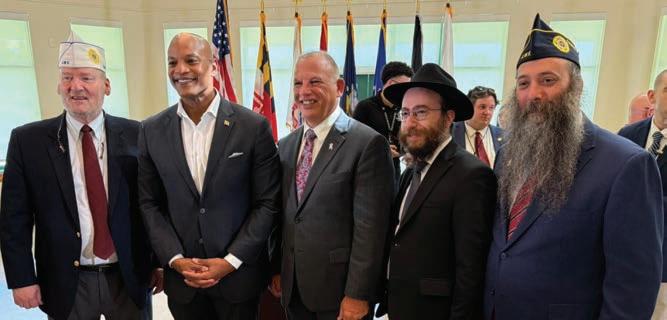
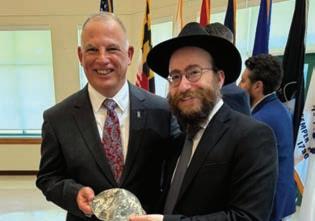

The Maryland Free State Post 167 of the Jewish War Veterans of the USA extends a heartfelt mazal tov to newly appointed Secretary Ed Rothstein on his new role. We look forward to supporting him and his team as they serve the more than
360,000 veterans and their families who call Maryland home.
May his leadership be marked by strength, compassion, and an unwavering commitment to those who have served.
















Program to Support Advanced Surgical Technologies and Education to Enhance Patient Care and Training Across the Health System
A $10 million gift from The Kahlert Foundation to LifeBridge Health will allow the community health system to invest in advanced and emerging surgical technologies to enhance patient care and medical training through the establishment of the Kahlert Surgical Innovation Institute.
“The Kahlert Surgical Innovation Institute will expand access to advanced surgical technologies across our health system, supporting our teams in delivering high-quality, innovative care. We are deeply grateful to The Kahlert Foundation for this transformational gift and their commitment to improving healthcare and strengthening our communities,” says Neil Meltzer, president and CEO of LifeBridge Health.
“We are excited to support a bold initiative that builds on the strength of LifeBridge Health’s clinical programs and embraces the promise of technology,” says Greg Kahlert, president of The Kahlert Foundation. “But technology alone doesn’t improve care; it takes knowledge, practice and teamwork. That’s why a central focus of the Institute will be education and hands-on training, equipping surgeons, residents, medical students and clinical teams with the skills and experience to deliver exceptional care.”
The Kahlert Surgical Innovation Institute will serve as a hub for integrating advanced tools and techniques, including robotics, artificial intelligence and simulation-based training, into real-world care. With a focus on education, collaboration and continuous improvement, the Institute will help LifeBridge Health remain at the forefront of surgical excellence.
“Surgical practice is advancing rapidly; however, innovation isn’t about adopting technology for its own sake. It’s about choosing the right state-ofthe-art tools to meet the needs of the people we serve and ensuring that our
providers have the education and training to use these technologies effectively,” says Joseph Bennett, M.D., chief of surgery at LifeBridge Health. “We are thankful to The Kahlert Foundation for entrusting us with their vision to invest in healthcare innovation and education to elevate care for people in our communities.”
The gift from The Kahlert Foundation is the largest single gift to LifeBridge Health itself in the health system’s 27-year history. The Kahlert Surgical Innovation Institute will be based at Carroll Hospital in Westminster, Northwest Hospital in Randallstown and Sinai Hospital of Baltimore. At Sinai, the Kahlert Institute will support faculty positions for the Regional Medical Campus with George Washington University School of Medicine and Health Sciences where third- and fourth-year medical students do their clinical rotations.
“Healthcare and education are central to The Kahlert Foundation’s mission, and community is at the heart of everything we do,” says Ellen Finnerty Myers, vice president and executive director of The Kahlert Foundation. “The Kahlert Surgical Innovation Institute brings these priorities together through a powerful partnership with LifeBridge Health— an organization that shares our deep commitment to improving lives across our shared communities.”
The Kahlert Surgical Innovation Institute builds on a long-standing relationship with LifeBridge Health. A $5 million gift to the Carroll Hospital Foundation in 2014 helped fund the construction of the William E. Kahlert Regional Cancer Center, named in honor of Greg Kahlert’s late father, who established the foundation in 1991 and co-founded Carroll County-based manufacturing company EVAPCO.
The Kahlert Foundation has also supported Couplet Care in the Family Birthplace at Carroll Hospital, hospice care and The Kahlert Foundation Simulation Center, which opened in 2023. Most recently, the foundation contributed funds to purchase a state-of-the-art linear accelerator
By: BJLife Newsroom



for advanced cancer treatment at the William E. Kahlert Regional Cancer Center. The Kahlert Foundation also supported a 3D printer used to create custom assistive devices for rehabilitation patients through the Anil Bhave Biomechanics & Engineering Labs Research Division in the Rehabilitation Institute at Sinai.
“LifeBridge Health truly lives its mission to care for the people in the communities it serves, and it’s espe-
cially meaningful that many EVAPCO employees are part of those communities and will benefit from this partnership,” concludes Greg Kahlert. “The Kahlert Surgical Innovation Institute reflects my father’s belief in the power of innovation and teamwork, and we are proud to continue his legacy by helping to advance care in our communities for generations to come.”







More than 400 people gathered Wednesday night at the DoubleTree by Hilton in Pikesville for an emotional tribute marking the first yahrzeit of Mrs. Miriam Mintz (née Fink), a beloved special educator at the Talmudical Academy of Baltimore. The evening served both as a heartfelt memorial and the public launch of a major new initiative: the creation of Miriam’s Library, a future hub of learning and growth for children and families in the Baltimore Jewish community.
The event was organized and spearheaded by Miriam’s husband, Mendel Mintz, who is leading the effort to bring the vision of Miriam’s Library to life.
The program opened with remarks by R’ Dov Yehuda Unger, who welcomed the crowd on behalf of the family and thanked those involved in organizing the event. Rabbi Yechezkel Zweig of Bais Yaakov and Rabbi Yonasan Seidman, rav of Kehillas Bnei Torah, followed with words
reflecting on Miriam’s impact as an educator and role model.
A 22-minute film presentation, produced by KolRom Media, featured 26 interviewees — including family members, colleagues, friends, and students — who shared personal memories and reflections on Miriam’s life, character, and educational mission. She taught for over a decade at TA’s Lamdeinu Center, where she supported children with patience, clarity, and deep personal care.
The event also marked the announcement of a major capital project: Miriam’s Library — a 14,000 square foot building already under contract to be purchased. The center will include after-school programming, a children’s library, academic resources, and educational services. Over $1.2 million has already been raised toward the $3 million campaign goal.
Rabbi Shais Taub served as the keynote speaker, addressing the audience


with a message that resonated deeply. His remarks capped off an evening filled with emotion, insight, and a shared sense of purpose among those present.
While the night was dedicated to remembering, it was equally focused on building forward. The tribute marked the beginning of a long-term effort to


ensure that Miriam’s values — education, dignity, and strength — continue to shape lives in a lasting way.
AUGUST
9:30 am
Yoga with Deborah Bandos
11:00 am
Discussion Group with Rabbi KarpInsights From Parshas Devorim
1:00 am
Arts & Crafts with Shifra
1:45 pm
Guitar with Yossi K
TUE 5
AUGUST
9:30 am
Yoga with Deborah Bandos
10:15 am
Anagrams with Malka Zweig
11:00 am
To learn more or support the project, visit MiriamsLegacy.org. AUGUST
Discussion Group with Rabbi KarpInteresting Customs From Around The World WED 6
1:00 am BINGO
1:45 pm
Guitar with Yossi K
9:30 am
Yoga with Deborah Bandos
AUGUST 10:15 am
Anagrams with Malka Zweig
11:00 am
Discussion Group with Rabbi Karp- The History and Meaning of Tu B'Av THU 7
1:00 am
Arts & Crafts with Shifra
1:45 pm
Guitar with Yossi K
2:00 pm Chizuk Roundtable (women only)
9:30 am
Anagrams with Malka Zweig
11:00 am
Discussion Group with Rabbi Karp- Determining the Correct Blessing for Produce FRI 8
Yoga with Deborah Bandos 1:00 am
Arts & Crafts with Shifra
2:00 pm Music with Mr Fried AUGUST 10:15 am
9:45 am
Yoga with Deborah Bandos
Discussion Group with Rabbi KarpParshas Vaeschanan Dilemmas
1:00 am
Music with Aharon Grayson AUGUST 11:00 am
(NOT ANYMORE)
This past Thursday night, Kehillas Shaar Simcha had the privilege of welcoming Rav Aaron Lopiansky, Rosh Yeshiva of Yeshiva of Greater Washington, for an uplifting and intimate Leil Shishi The event brought together members of the Chevra for a night of inspiration, connection, and reflection.
Rav Lopiansky spoke about the delicate balance between structure and spontaneity in both our avodas Hashem and our relationships. Drawing from the concept of the daily korban tamid—offered consistently every morning and evening—alongside the special offerings brought on Yomim Tovim, he illustrated
how a meaningful life must integrate both steady commitment and moments of heartfelt, spontaneous inspiration.
“In any relationship,” he explained, “whether between husband and wife or between a Yid and the Ribbono Shel Olam, we must avoid falling into rote routine, but also be cautious not to rely solely on bursts of excitement that come and go. True growth lies in finding the balance between the two.”
Following his talk, Rav Lopiansky graciously stayed to answer questions and connect further with the attendees. He also offered a personal message to the special group that gathers every
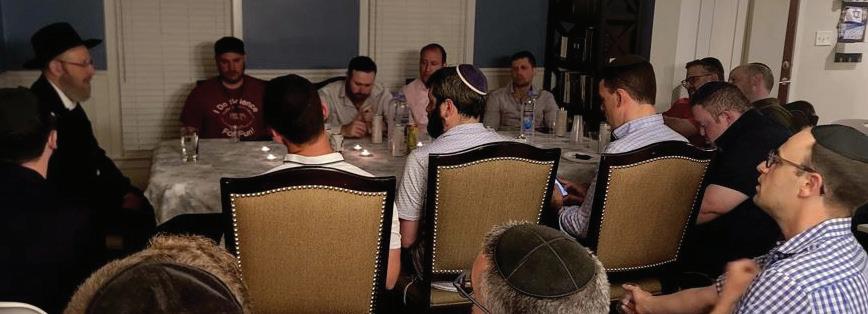
Friday night for a spirited and soulful Kabbalas Shabbos. “Recognizing the gift of Shabbos as a time that lifts us out of the mundane week,” he said, “is reason enough to sing and dance. That joy and perspective should guide your tefillos and your gatherings each and every week.”
Kehillas Shaar Simcha continues to bring together Yidden from across the community to share meaningful experiences, grow in their Yiddishkeit, and elevate one another. This Leil Shishi was another powerful step in that journey.
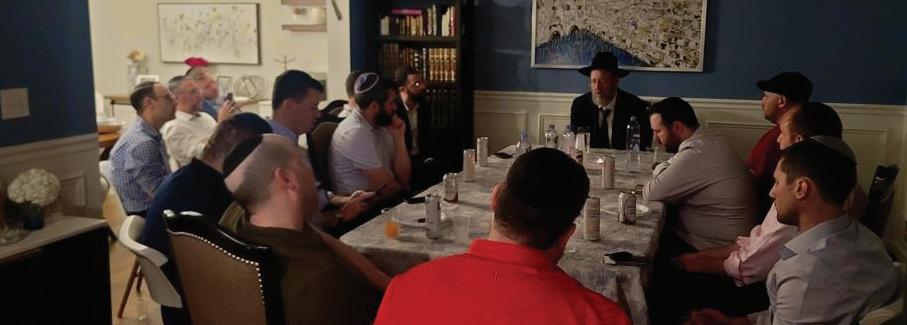
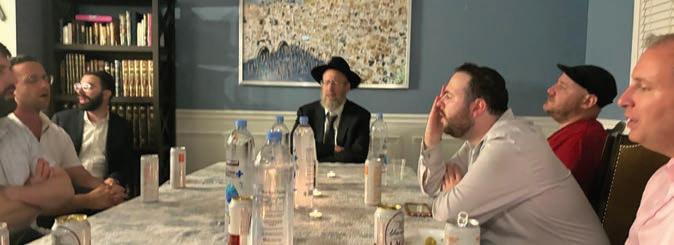
6:15 am Young Israel Shomrai Emunah M-F
6:25 am Southeast Hebrew Cong., Knesset Yehoshua M-F
6:30 am Beth Sholom Congregation M-F
Beit Halevi (Sfardi) M, T
Chabad of Silver Spring M-F
Ohev Shalom Talmud Torah OLNEY M-F
Young Israel Shomrai Emunah S YGW M, Th
6:35 am Ohr Hatorah M, Th
6:40 am YGW S, T, W, F
Magen David Sephardic Congregation M-Th
6:45 am Beit Halevi (Sfardi) S, T, W, F
Kemp Mill Synagogue M, Th
Ohr Hatorah T, W, F
Young Israel Shomrai Emunah M, Th
6:50 am Woodside Synagogue/Ahavas Torah M, Th Silver Spring Jewish Center M-F
Chabad of Upper Montgomery County M-F
6:55 am Young Israel Shomrai Emunah T, W, F
7:00 am Kemp Mill Synagogue T, W, F
Southeast Hebrew Cong., Knesset Yehoshua S Silver Spring Jewish Center S
Woodside Synagogue/Ahavas Torah T, W, F
Young Israel Ezras Israel of Potomac T, W, F
7:05 am Kesher Israel M, Th
7:15 am Kemp Mill Synagogue M, Th Kesher Israel T, W, F
Ohev Sholom Talmud Torah/The National Synagogue M-F
Ohr Hatorah S
7:30 am Chabad of DC M-F
Chabad of Potomac M-F
JROC M-F
Kemp Mill Synagogue T, W, F
Southeast Hebrew Cong., Knesset Yehoshua M-F
Young Israel Shomrai Emunah S
Young Israel Shomrai Emunah (Sfardi) M-F
7:45 am YGW (Yeshiva Session Only) S-F
8:00 am Beth Sholom Congregation S
Kemp Mill Synagogue S
Kesher Israel S
Ohev Shalom Talmud Torah OLNEY S
Southeast Hebrew Cong., Knesset Yehoshua S
Chabad of Upper Montgomery County S Woodside Synagogue/Ahavas Torah S
8:00 am YGW (High School; School-Contingent) S-F
Young Israel Ezras Israel of Potomac S Young Israel Shomrai Emunah (Sfardi) S
8:05 am Ezras Israel Congregation of Rockville M, Th
8:15 am Ohr Hatorah S Ezras Israel Congregation of Rockville S, T, W, F
Kehilat Pardes / Berman Hebrew Academy S-F
Silver Spring Jewish Center M-F
8:30 am Chabad of DC S Chabad of Potomac S JROC S Ohev Sholom Talmud Torah/The National Synagogue S
Silver Spring Jewish Center S YGW (Summer Only) S-F
8:45 am Young Israel Shomrai Emunah S-F
9:00 am Chabad of Silver Spring S Kemp Mill Synagogue S
mincha
2:15 pm Silver Spring Jewish Center S-F
2:20 pm YGW M, T, W
2:45 pm YGW M-Th
3:00 pm YGW Middle School School Days
Before Shkiah (15-18 minutes), S-TH
Beit Halevi (Sfardi)
Beth Sholom Congregation
Chabad of Potomac
Chabad of Silver Spring
Chabad of Upper Montgomery County
Ezras Israel Congregation of Rockville (20 min before, S-F) JROC
Kemp Mill Synagogue
Kesher Israel
Magen David Sephardic Congregation
Ohev Sholom Talmud Torah/The National Synagogue
Ohr Hatorah
Silver Spring Jewish Center
Southeast Hebrew Congregation
Woodside Synagogue/Ahavas Torah
Young Israel Ezras Israel of Potomac
Young Israel Shomrai Emunah (Asheknaz) Young Israel Shomrai Emunah (Sefarhadi) maariv
8:15 pm OSTT (OLNEY) S-Th
8:45 pm



Prior to this week, Australia had strict restrictions on U.S. beef imports in an effort to keep the country free of mad cow disease. This week, it announced that it would relax those restrictions, leading U.S. President Donald Trump’s administration to claim a major victory over “non-scientific trade barriers.”
Australia’s Agriculture Minister Julie
Collins said on Thursday that relaxing the restrictions designed to keep Australia free of mad cow disease, also known as bovine spongiform encephalopathy or BSE, would not compromise biosecurity.
“Australia stands for open and free trade — our cattle industry has significantly benefited from this,” Collins said in a statement.
Trump celebrated the announcement with a post on Truth Social. “Now, we are going to sell so much to Australia because this is undeniable and irrefutable Proof that U.S. Beef is the Safest and Best in the entire World,” he said.
U.S. Secretary of Agriculture Brooke L. Rollins responded to Australia’s announcement by congratulating Trump on a “major trade breakthrough that gives greater access to U.S. beef producers selling to Australia.”
“This is yet another example of the kind of market access the President negotiates to bring America into a new golden age of prosperity, with American agriculture leading the way,” she said in a statement.
Australia has allowed imports of beef grown in the United States since 2019.
But Australia has not allowed imports from the U.S. of beef sourced from Canada or Mexico because of the disease risk. The U.S. recently introduced additional movement controls that identify and trace all cattle from Mexico and Canada to their farms of origin.
In April, Trump attacked Australian import restrictions on U.S. beef when he announced that tariffs of at least 10% would be placed on Australian imports, with steel and aluminum facing a 50% tariff.
“Australia bans — and they’re wonderful people, and wonderful everything — but they ban American beef,” Trump told reporters then. “Yet we imported $3 billion of Australian beef from them just last year alone. They won’t take any of our beef. They don’t want it because they don’t want it to affect their farmers and, you know, I don’t blame them, but we’re doing the same thing right now,” Trump added.
Around 70% of Australian beef is exported. The price of U.S. beef has been rising due to drought and shrinking herd numbers. As such, demand for U.S. beef in Australia is expected to remain low.

Former UK Labour leader Jeremy Corbyn recently announced that he was forming a new political party that will push for a “mass redistribution of wealth and power” and a “free and independent Palestine,” opposing all British arms sales to Israel.
The MP announced the party alongside fellow independent MP Zarah Sultana, who was suspended by Labour last year after she and several other members of parliament voted to scrap a controversial cap on child benefits.
The two lawmakers said their new















































left-wing party will be called Your Party.
“We will only fix the crises in our society with a mass redistribution of wealth and power,” they said, calling for raising taxes on the wealthy, nationalizing utilities, challenging fossil fuel companies, and boosting public housing.
“Meanwhile, millions of people are horrified by the government’s complicity in crimes against humanity. Now, more than ever, we must defend the right to protest against genocide,” it continued, in an apparent reference to the UK’s recent ban of an anti-Israel activist group as a terror organization, following its attacks on British military sites.
“We believe in the radical idea that all human life has equal value. That is why we will keep demanding an end to all arms sales to Israel, and the only path to peace: a free and independent Palestine,” they said.
UK Prime Minister Keir Starmer has sought to pull Labour to the center since succeeding Corbyn as leader. He has been facing growing calls within his party to recognize a Palestinian state.
Both Corbyn and Sultana have been accused of antisemitism in their comments about the war in Gaza.
Corbyn was slow to explicitly condemn the atrocities by Hamas on October 7 and initially refused to call the group — whose members once thanked him for his “support and solidarity with the Palestinian people” — a “terror group,” or to advocate its deposition as the de facto government of Gaza.
Since then, Corbyn has called for a total arms embargo on Israel as it battles the Hamas terror group and seeks to bring home the hostages that Hamas kidnapped on October 7.
But even prior to October 7 Corbyn showed an antisemitic streak. He endorsed a mural that appeared to show an antisemitic caricature; he wrote a glowing foreword to a book that claims Jews control global financial systems; he called terror groups Hamas and Hezbollah “friends” when inviting members for a parliamentary meeting in 2009; and he attended a ceremony that honored the terrorists behind the 1972 Munich Olympic massacre.
In 2020, a UK government investigation found in Labour under Corbyn “a culture within the party which, at best, did not do enough to prevent antisemitism and, at worst, could be seen to accept it.” The party ousted Corbyn after he responded to the report by
saying that the problem of antisemitism had been “dramatically overstated for political reasons.”
Sultana, for her part, said in since-deleted social media posts from 2015 that she would celebrate the deaths of former UK prime minister Tony Blair, former U.S. president George W. Bush and Prime Minister Benjamin Netanyahu. She also wrote that she supported “violent resistance” by Palestinians and that Zionism is a racist ideology.

Around 35 members of the Jewish community in Iran were arrested at the conclusion of Israel’s 12-day war with Iran. All of those people, except for five of them, have been released.
Two of those who had been arrested were U.S.-Iranian citizens who found themselves caught in the government crackdown. They both live in the U.S. and were visiting family when the war broke out.
“They were in the wrong place at the wrong time,” one person said.
One of those Americans lives in Los Angeles and was released on bail a few days ago. The other, who is still being held, has lived in New York for at least 30 years.
The remaining three Jews held were detained because they posted to social media against the regime, or liked such posts by others.
The Jewish representative in the Iranian parliament, Homayoun Sameyah Najaf Abadi, in an update on Saturday said that he had met with the head of the Iranian Revolutionary Guards Corps judiciary, which is handling the cases, and reached an agreement to release most of the detainees.
Najaf Abadi said that the espionage charges against all the detainees have been rejected.
“We hope that as a result of continued cooperation, the remaining prob-

lems will soon be resolved,” he was quoted by Ynet as saying. The report did not specify which of the five detainees would be released and which would remain behind bars.
Arrests of Jewish community members were made in Tehran, Shiraz, and Alborz province.
Supposedly, Iranian officials had been looking for collaborators with Israel. One person said they were checking cellphones of those who were arrested to see if any calls had been made to Israel. In the past, calls made to people in Israel had been quietly tolerated even though any connection to Israel is unlawful.
Aside from members of the Jewish community, more than 700 other people have been detained by authorities since June 13, when Israel launched its surprise attack on Iran.
There are around 10,000 Jews still living in Iran.
In June, a fire broke out in a 67-story apartment building in the Dubai Marina district of Dubai, forcing over 3,800 residents to evacuate. Though no one sustained significant injuries, the fire prompted authorities to crack down on partitioned apartments.
The building had 532 occupied apartments, which means that around seven people resided in each unit, even though the building only has one, two, and three-bedroom apartments.
Many underpaid migrant workers rent space in cramped, partitioned apartments. One unit can be divided up into several small rooms with plywood boards, drywall, or plastic shower curtains, allowing one apartment to house 10 or even 20 people. Some people live in closets that can only accommodate a mattress. Others pay a few dollars a night to live on a bunk bed with no privacy.
The majority of Dubai’s migrant workers, many of whom come from Asia and Africa, are paid $300 to $550 a month. In general, space in a partitioned apartment costs $220 to $270 a month, while a legal one-bedroom rental costs around $1,400 a month, according to real estate firm Engel & Völkers. Dubai has few options for low-income workers, with around a fifth of homes in the city state valued at over
$1 million in 2024, according to Knight Frank, a property firm.
Workers at large companies, including resorts, hotels, factories, and construction firms, who make less than $400 a month, are entitled to housing. However, since many migrants work off the books, they can’t claim those benefits. As such, many can only afford to rent space in illegal partitioned apartments. Only Emirati nationals are entitled to government financial assistance for housing.
Now that officials in Dubai are cracking down on illegal subletting, many migrants live in fear, since they have nowhere else to live in the event that they’re forced to leave their cramped living quarters.

On Monday, Judge Sandra Liliana Heredia found former Colombian President Alvaro Uribe guilty of abuse of process and bribery of a public official, making him Colombia’s first former president to be convicted of a crime in court.
Uribe, a 73-year-old right-wing politician who served as president from 2002 to 2010, was accused around 13 years ago of tampering with witnesses, kicking off a case against him that has continued since.
Heredia spent around nine hours reading out loud her decision, which was about 1,000 pages long in full, to the court. The judge will sentence Uribe at another time. For each charge, Uribe can receive six to 12 years in prison. If the conviction survives appeals, Uribe may serve his sentence under house arrest due to his age.
“Justice does not kneel before power,” Heredia declared. “It is at the service of the Colombian people.”
“We want to say to Colombia that justice has arrived,” Heredia added.
Uribe and Jaime Granados, one of his lawyers, were present virtually during the hearing. Jaime Lombana, another lawyer, was there in person.
“This is not the end of this process. The appeal is next, and we are going to demonstrate that this decision, which we respect, is wrong,” said Juan Felipe Amaya, one of Uribe’s lawyers.
Granados asked for Uribe to still be presumed innocent and remain free for the time being. Uribe’s supporters claim that the trial is politically motivated. In less than a year, Colombia will hold its 2026 presidential election, which will feature a number of politicians allied and associated with Uribe.
According to the accusation, Uribe tampered with witnesses in an effort to disprove allegations that he was illegally associated with paramilitary groups.
As president, Uribe shared a warm relationship with the United States.
“Uribe’s only crime has been to tirelessly fight and defend his homeland. The weaponization of Colombia’s judicial branch by radical judges has now set a worrisome precedent,” U.S. Secretary of State Marco Rubio said.

On Thursday, an Antonov An-24 plane with 48 passengers onboard crashed in Russia during a failed landing at Tynda Airport. Everyone on the Soviet-era twin-propeller plane was killed.
The craft, which was built in 1976, was operated by Angara Airlines. It departed from Blagoveshchensk and was headed to Tynda, a town in eastern Russia. The plane tried to land twice, crashing in a forested area around ten miles from Tynda after its second attempt. At around 1 p.m. local time, it went off the radar. Later, it was found by a rescue helicopter.
At a Russian submarine development meeting, Russian President Vladimir Putin offered his “condolences to the relatives, friends, and all the families of those killed in this air crash,” declaring a moment of silence. The Amur region’s governor declared three days of mourning for the area.
Russian officials, suspecting that human error and technical issues played a role in the crash, have launched a criminal investigation into the incident.
“In 2021, the aircraft’s airworthiness certificate was extended until 2036,” according to Russian state media.
However, the crash has led many to question the old plane’s integrity. Since 2018, the craft has been involved in four relatively insignificant incidents.
In the Soviet Union, nearly 1,340 An-24 planes were built, of which 75 are in still operation, 88 have been lost in crashes, and 65 have been lost in non-fatal accidents. Western sanctions have played a role in Russia’s ability to maintain its aircraft.
On Thursday, clashes between Thailand and Cambodia began near their disputed border, with both countries launching airstrikes at each other. Since then, 38 or more people have died, and hundreds of thousands have been displaced because of the conflict, which had the potential of becoming an all-out war.
However, on Monday at midnight, a truce went into effect, following a handshake between acting Thai Prime Minister Phumtham Wechayachai and Cambodian Prime Minister Hun Manet.

“The United States applauds the ceasefire declaration between Cambodia and Thailand announced today in Kuala Lumpur,” U.S. Secretary of State Marco Rubio said on Monday. “President Trump and I are committed to an immediate cessation of violence and expect the governments of Cambodia and Thailand to fully honor their commitments to end this conflict.”
Officials from the United States and Malaysia led the negotiations at Malaysian Prime Minister Anwar Ibrahim’s official residence. During the meeting, U.S. ambassador to Malaysia Edgard







Kagan was the U.S.’s top diplomat. Chinese diplomats were also present, acting as observers. Anwar issued an announcement, noting that, on Tuesday at 7 a.m., military commanders from Thailand and Cambodia would hold an informal meeting. If both countries agree, two more meetings — one with military attachés, and the other on August 4, held by Cambodia — could take place.
U.S. President Donald Trump threatened that the U.S. wouldn’t hold trade deal negotiations with Thailand and Cambodia until the conflict ends. Recently, Trump said he would levy 36% tariffs on Thailand, Cambodia, and 10 other countries, unless trade deals are reached by August 1. That threat may have pushed Thailand, which is desperate to avoid U.S. tariffs due to its weak economy, to accept the truce.
“I have now ended many Wars [sic] in just six months — I am proud to be the president of PEACE!” wrote Trump in a Truth Social post.
Talks between the U.S. and the two countries resumed after the ceasefire was reached.
The dispute between Thailand and Cambodia dates back more than a century, to when France, which occupied Cambodia until 1953, first mapped the land border. Clashes over the 508-mile border have erupted over the years. The most recent episode began in May, when troops briefly exchanged fire at a contested area, killing a Cambodian soldier. This led to a series of tit-for-tat actions by both governments: Thailand imposed border restrictions with Cambodia, while Cambodia banned imports of fruit and vegetables, broadcasts of Thai films, and cut internet bandwidth from Thailand, among other measures.
Tensions were enflamed last week when five Thai military personnel were injured by landmines while on patrol. They accuse Cambodia of laying the landmines recently, an accusation Cambodia denies.
Sgt. Yinon Nuriel Vana — were killed in an explosion in Khan Younis. That same day, a third soldier, Sgt. Maj. (res.) Bezalel Yehoshua Mosbacher, succumbed to wounds he sustained in a separate attack in Khan Younis a week prior.
Saad and Vana were killed when an explosive device hit the Namer armored personnel carrier they were inside. Saad and Mosbacher were buried on Sunday, while Vana was laid to rest on Monday morning.
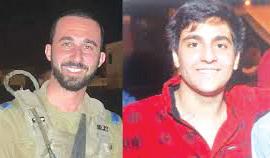
Saad, 22, was from the Druze town of Yanuh-Jat. During his funeral, Sheik Muafak Tarif, the leader of the Druze community in Israel, eulogized the fallen soldier.
“How difficult it is to stand here again, to once again lay a fallen IDF soldier to rest in the same place and the same village,” said Tarif during the funeral, recalling that Saad’s cousin, Alim, was murdered during a Hezbollah terrorist attack on October 9, 2023.
“In any situation and at any time, the pains of peace are preferable to the agonies of war,” Tarif added, offering his condolences to the families of Vana and Mosbacher. “I hope and pray that an agreement will be reached in the south, that we will see the hostages return, and that we can return to routine life in the country.”
During the roadside bomb attack that critically injured Mosbacher, 32, on July 19, another combat engineer was seriously wounded. The two were attacked while driving a jeep in Khan Younis.
On Saturday evening, two IDF soldiers in the Technology and Maintenance Corps serving in the Golani Brigade’s reconnaissance unit — Cpt. Amir Saad and
Mosbacher, who succumbed to his injuries a week later, was a reservist from the city of Or Yehuda, which is near Tel Aviv. He grew up in Aveni Eitan in the Golan Heights. On Sunday, Mosbacher was laid to rest at the Mount Herzl military cemetery in Jerusalem. He leaves behind his parents, Yaakov and Hannah, and 10 siblings, as well as his wife, Maayan, and his infant daughter. Before he passed away, Mosbacher was able to communicate with his family.
“In the last week, you gave us instructions. What to do with Maayan [and] your daughter… We will take care of Maayan, Yaeli, and the baby on the way,” vowed
SINAI HOSPITAL
1st floor, off the Blaustein
Lobby
JOHNS HOPKINS
1st Floor, Blalock Room 175
GBMC
New Building, Main Entrance, Adjacent to the Spiritual Care offices – Room 3281
UNIVERSITY OF MD
MEDICAL CENTER
6th Floor, Gudelsky Conference room
UNION MEMORIAL
First floor, Johnson Professional Building across from the Zen Meditation Garden
one of his brothers, Shmuel, during the funeral, thanking the fallen soldier for “32 years of joy.”
“He parted from us quietly that week. He and [G-d] had come to terms a week earlier, and he gave him time. His [G-d’s] plan was fulfilled,” said Mosbacher’s father during his eulogy.
“Let’s hope there won’t be more problems in Israel… There is so much pain in this war,” he added. “The madmen that don’t understand what life is — let us hope that they wake up and understand that there is a nation here that understands and knows what it means to preserve life. This life is a gift. One has no right to treat it as if it’s something bought at the market.”
Mosbacher’s mother said he “filled the world with so much light, joy, wisdom, and love.”
“In the end, you were also ready to give your life for the sake of your nation,” she said. “My love for you is eternal. I wish you could have stayed here longer. I now have to give back to the Creator the greatest gift in the world, and it’s hard. Love is eternal, and we are connected forever and ever.”
On a Sunday morning Facebook post, Nava Nuriel, the mother of Vana, wrote, “For two days now, I’ve known deep inside that you would come to me. I’ve been preparing myself for the worst, wondering how I’ll cope, what I’ll do. For two days, I’ve felt it – and pushed it away. But nothing prepares a mother for the knock at the door.”
“My little Yinon. My beloved. The whole world is crying for you now, and I find myself asking for forgiveness – for not holding you tightly enough the last time. Then came the knock at the door: ‘We won’t leave you. We are here for you.’ And in that moment, I disappeared into the abyss. Now, all I can do is begin the long climb out,” she wrote. “With deepest sorrow, we announce our joining of the family no one wishes to join – the family of the bereaved. Our Yinon is gone.”
The three fallen soldiers were hailed as heroes by Israeli officials, including Defense Minister Israel Katz and opposition leader Yair Lapid.
Though another ceasefire-hostage deal seemed imminent, talks fell through on Thursday after Hamas responded to a 60-day truce proposal with several unre-
alistic demands. In response, U.S. special envoy Steve Witkoff announced that the United States’ negotiating team would be returning home because Hamas demonstrated “a lack of desire to reach a ceasefire.”
Previously, the terrorist group said it would free all 50 of the remaining hostages it has held for nearly two years — 20 of whom are believed to be alive — if Israel completely withdraws from the Gaza Strip, leaving the militant group in power. The Jewish state maintains that the war will only end once all hostages are freed and Hamas is demilitarized and no longer in control of Gaza.

“While the mediators have made a great effort, Hamas does not appear to be coordinated or acting in good faith,” Witkoff stated, calling Hamas’s actions “selfish” and affirming the U.S.’s commitment to peace in the region. “We will now consider alternative options to bring the hostages home and try to create a more stable environment for the people of Gaza.”
It is unclear what alternative options the U.S. is weighing.
On Thursday, Israeli Prime Minister Benjamin Netanyahu also ordered Israel’s negotiating team home from Doha.
Previously, Israel had agreed to release 125 Palestinians serving life sentences along with 1,200 other prisoners. However, Hamas reportedly demanded the release of 200 terrorists and 2,000 others held in Gaza since October 7, 2023, in exchange for 10 living hostages and the bodies of 18 deceased hostages, who would be released in five batches over the span of two months.
“Ultimately, the special envoy statement speaks for itself, but I think the broader context here is also important. The fact that we have seen Hamas first break that ceasefire that existed on Oct. 7, then break another ceasefire, and then, here, as the special envoy makes clear, not acting in a way in order to achieve a ceasefire again,” said U.S. State Department principal deputy spokesman Tommy Piggot. “So, to reiterate, the question has never been our commitment to a ceasefire. It has been Hamas’. They have shown that again and again and again
and have just shown it once again.”
On Friday, U.S. President Donald Trump suggested that a ceasefire may not be possible in the near future.
“Hamas didn’t really want to make a deal. I think they want to die,” Trump said, adding that he had predicted that the truce wouldn’t work out. “We got a lot of hostages out. But when you get down to the last 10 or 20, I don’t think Hamas is going to make a deal because that means they have no protection. And basically that’s what happened.”
“I think what’s going to happen is they’re going to be hunted down,” the president added. “It [has] gotten to a point where [Israel is] going to have to finish the job.”
Trump later added that Israel will have to decide its next move in the war. The president said that he knows how he would handle Hamas but refrained from specifying, adding that it would be inappropriate for him to weigh in.
On Friday, Egypt and Qatar said that they were still working to secure a ceasefire. The two countries asserted that the U.S. and Israel left the negotiation table only “to hold consultations before resuming dialogue,” which is “normal in the context of these complex negotiations.”
On Friday, several hostage families visited the White House to meet with Secretary of State Marco Rubio, who gave them an update on the talks. According to a family member of one of the hostages, the Trump administration told them that the U.S.’s decision to recall its negotiating team was merely a “muscle flex” tactic intended to pressure Hamas into dropping some of its demands.
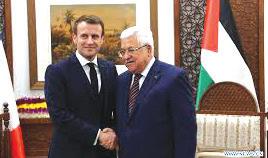
On Thursday, Emmanuel Macron, the president of France, announced in a post on X that his country would recognize a “Palestinian state” in September at the U.N. General Assembly. The largely symbolic move would make France, which hosts the largest Jewish population in Europe, the first major
Western country to recognize a state for the Palestinians.
Macron’s announcement was praised by both Hamas, the terror group that governs Gaza and led the October 7 attacks, and the Palestinian Authority, which controls parts of Judea and Samaria.
Hussein al-Sheikh, the deputy to Palestinian Authority President Mahmoud Abbas, said Paris’ gesture “reflects France’s commitment to international law and its support for the Palestinian people’s rights to self-determination and the establishment of our independent state.” Hamas called the move a “positive step in the right direction toward doing justice to our oppressed Palestinian people and supporting their legitimate right to self-determination.”
Macron claimed that the move will encourage the realization of a “twostate solution.” According to Macron, Abbas has promised him a reformed PA and vowed that a Palestinian state would be peaceful and demilitarized.
Meanwhile, Macron’s announcement was met with condemnation from the United States and Israel.
“This reckless decision only serves Hamas propaganda and sets back peace. It is a slap in the face to the victims of October 7,” said U.S. Secretary of State Marco Rubio.
Prime Minister Benjamin Netanyahu slammed Macron, noting that the French president was recognizing a “state next to Tel Aviv in the wake of the October 7 massacre.”
“Such a move rewards terror and risks creating another Iranian proxy, just as Gaza became. A Palestinian state in these conditions would be a launch pad to annihilate Israel — not to live in peace beside it,” said Netanyahu. “Let’s be clear: the Palestinians do not seek a state alongside Israel; they seek a state instead of Israel.”
Macron’s announcement came the same day that ceasefire talks fell through due to Hamas’ unwillingness to negotiate.
Ofir Sofer, the minister of immigration and absorption, urged French Jews to make aliyah. Other ministers mocked Macron on social media with memes and GIFs.
Israel has previously taken diplomatic action against countries that recognize a Palestinian state.
Some ministers are now calling for the annexation of Judea and Samaria
E D D I N G P A C K A G E


as a response to France’s move.
“I thank President Macron for providing yet another compelling reason to finally apply Israeli sovereignty over the historic regions of Judea and Samaria and to definitively abandon the failed concept of establishing a Palestinian terrorist state in the heart of the Land of Israel,” Finance Minister Bezalel Smotrich said in a post on X.
Justice Minister Yariv Levin also called for an annexation, which he said would be “a response of historical justice to the shameful decision of the French President.”
Yair Lapid, an opposition leader and former prime minister, condemned France’s planned recognition of a Palestinian state as “a moral error and diplomatically damaging,” adding that “the Palestinians should not be rewarded for October 7 and for supporting Hamas.” Naftali Bennett, another former prime minister, also slammed the French president’s announcement.
In a twist, Lapid blamed Netanyahu’s government for Macron’s move. “A functioning government doing basic diplomatic work could have prevented this harmful declaration,” Lapid claimed.
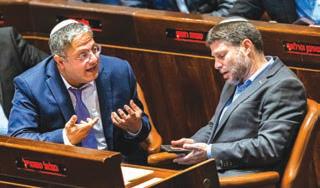
This week, the Netherlands announced a ban on Finance Minister Bezalel Smotrich and National Security Minister Itamar Ben Gvir from entering the country, the latest Western nation to bar the pair from visiting their nation.
Monday’s decision came as part of a slew of measures to pressure Israel over the humanitarian crisis in Gaza. The Dutch government will also summon Israel’s ambassador to the Netherlands, Modi Ephraim, to denounce the “unbearable and indefensible” situation in the Strip.
In a letter to Dutch lawmakers quoted by local newspaper Algemeen Dagblad, the Netherlands’ Foreign
Minister Caspar Valdekamp said the move against Smotrich and Ben Gvir came “because they have repeatedly incited violence by settlers against the Palestinian population and…called for ethnic cleansing in the Gaza Strip.”
The announcement is the latest sign of escalating tensions between Israel and the European Union, as well as the Netherlands specifically, as unsubstantiated reports of starvation in Gaza circulate around the world.
Two weeks ago, Foreign Minister Gideon Sa’ar held meetings with EU officials to stave off sanctions on Israel in exchange for an increase in aid entering Gaza. EU leaders have complained that Israel has not done enough, and are considering suspending Israel from a signature EU research funding program, a step Schoof said may be among “additional measures” his government could support.
On Tuesday, Sa’ar summoned Marriet Schuurman, the Dutch ambassador to Israel, for a reprimand at the Foreign Ministry in Jerusalem over the steps the Netherlands is pursuing regarding Israel.
“The conversation will take place in light of the Dutch government’s decisions to take measures against Israel, including against its right to self-defense and against ministers in its government,” Sa’ar’s office said.
The Netherlands is the second EU country to bar Smotrich and Ben Gvir; Slovenia announced its own ban earlier in July. The United Kingdom, Canada, Australia, New Zealand and Norway also banned the ministers last month. Separately, several EU countries, including the Netherlands, have weighed arresting Prime Minister Benjamin Netanyahu in compliance with an International Criminal Court arrest warrant.
Responding to the announcement, Smotrich and Ben Gvir both accused the Dutch government of siding with extremist forces and alluded to Europe’s history of antisemitism.
“Even if I’m banned from all of Europe, I’ll keep working for our country and demanding that we topple Hamas and back our fighters,” Ben Gvir, who chairs the Otzma Yehudit party, posted on X. “In a place where terrorism is tolerated and terrorists are welcome, a Jewish minister from Israel is unwelcome. Terrorists are free and Jews are boycotted.”
Smotrich accused the Netherlands’
Elementary School
For the 2025-2026 School Year
Upper & Lower Elementary Assistant Positions P/T and/or F/T
O ce Staff Member with strong computer and communication skills
Middle School
For the 2025-2026 School Year
Pre Algebra Teacher (1 period)
Gold Class Assistant (4 periods)
History Teacher (3 periods)
English Teacher (2 periods)
High School
For the 2025-2026 School Year
M-Th 2:50-3:35pm, English 10th Grade
M-Th 3:38-4:23pm, US History 9th Grade
M-Th 4:33-5:17pm, English 10th Grade
M-Th 5:20-6:05pm, English 9th Grade
M-Th 4:33-6:05pm, AP Calculus
M-Th 2:55-6:00pm, Resource Assistance focus on Math inc. Alg I & II, Gemoetry
government of surrendering “to the lies of radical Islam.” He wrote regarding Europe that “Jews will not be able to live there in security in the future either,” just as they were not able to in the past.
“What they don’t understand in the Netherlands and other European countries is that, far more than it matters to me to enter the Netherlands, it matters to me that my children, grandchildren and great-grandchildren, and those of all the Jews in the world, can live in the State of Israel in security for decades and centuries to come,” Smotrich, who chairs the Religious Zionism party, posted on X.

On Saturday, Israel intercepted a ship carrying 21 activists trying to break through the Jewish state’s maritime
blockade on the Gaza Strip. The anti-Israel activists were aboard the Gaza-bound Handala, which departed Sicily in early July. The Israeli navy seized the ship around 40 miles from Gaza just before midnight.
On Sunday, Israeli authorities brought the vessel to the port of Ashdod, with the Foreign Ministry confirming the passengers’ safety.
The flotilla was sent by the Freedom Flotilla Coalition, the same organization that, a few weeks ago, dispatched the Madleen, another Gaza-bound vessel intercepted by the Israel Navy. The Madleen, which carried 12 activists including Greta Thunberg, had the same goals as the Handala. Both ships carried tiny aid packages intended for Gazans, mainly their goal was for show.
Among those on board were two French MPs, Emma Fourreau and Gabrielle Cathala — both members of the leftwing France Unbowed party — and two Al Jazeera journalists.
On Monday, Israel was expected to hold hearings for 13 of the activists, including Braedon Peluso and Christian Smalls from the United States; Robert Martin and Tania (Tan) Safi of Australia;
Justine Kempf of France; Fourreau from France and Sweden; Antonio La Picirella from Italy; Chloé Fiona Ludden of the United Kingdom and France; Sergio Toribio Sanchez and Santiago González Vallejo of Spain; Vigdis Bjorvand of Norway; and Hatem Aouini of Tunisia.
Antonio Mazzeo, a citizen of Italy; Cathala, the French MP; Jacob Berger, a U.S. citizen; Waad Al Musa, who holds dual U.S. and Iraqi citizenship; and Mohamed El Bakkali from Morocco, were already deported. Two other activists, Bob Suberi and Huwaida Arraf, who hold citizenship in the U.S. and Israel, were being held by police, according to pro-Palestinian legal organization Adalah, whose lawyers are representing the activists.
This week, Samsung Electronics announced that it has entered into a
$16.5 billion contract for supplying semiconductors to Tesla.
The memory chipmaker, which had not named the counterparty, mentioned in its regulatory filing that the effective start date of the contract was July 26, 2025 — receipt of orders — and its end date was December 31, 2033.
Tesla CEO Elon Musk posted on X, “Samsung’s giant new Texas fab will be dedicated to making Tesla’s next-generation AI6 chip. The strategic importance of this is hard to overstate. Samsung currently makes AI4. TSMC will make AI5, which just finished design, initially in Taiwan and then Arizona.”
He added, “Samsung agreed to allow Tesla to assist in maximizing manufacturing efficiency. This is a critical point, as I will walk the line personally to accelerate the pace of progress.” He suggested that the deal with Samsung could likely be even larger than the announced $16.5 billion.
Samsung’s foundry service manufactures chips based on designs provided by other companies rather than



designing and manufacturing its own chips like Integrated Device Manufacturers (IDMs) do. It is the second largest provider of foundry services globally, behind Taiwan Semiconductor Manufacturing Company.

The company stated in April that it aimed to commence 2 nanometer mass production in its foundry business and secure major orders for the next-generation technology. In semiconductor technology, smaller nanometer sizes signify more compact transistor designs, which lead to greater processing power and efficiency.
Local South Korean media outlets have also reported that American chip firm Qualcomm could place an order for chips manufactured using Samsung’s 2 nanometer technology.
Joseph Czuba was convicted and sentenced to 53 years in prison in May for the murder of Wadea al-Fayoume, a six-year-old Palestinian American boy who had been Czuba’s tenant in Plainfield, Illinois, in 2023. Czuba was also found guilty of severely wounding and the attempted murder of the boy’s mother, Hanaan Shaheen. Last week, Czuba died in prison just months after beginning his sentence.
Police say the landlord targeted the pair for their Islamic faith shortly after the start of the Israel-Gaza war.
Czuba was 73 years old.
The family had been renting rooms from Czuba when the attack took place. Police say Czuba stabbed al-Fayoume 26 times. The boy later died in hospital.
Czuba was convicted of two counts of hate crime, one count of first-degree murder, one count of attempted murder and two of aggravated battery.
His mother testified in court that Czuba had also attacked her with a
knife before moving on to her son, telling her, “You, as a Muslim, must die.”
Ahmed Rehab, the executive director of the Council on American-Islamic Relations’ Chicago office, said in a statement after Czuba’s death that while “this depraved killer has died, the hate is still alive and well.”
Many Palestinians live in Plainfield.
Last week, a nine-year-old girl lost her life at The Boardwalk water park in Hersheypark. The tragedy took place at the wave pool.
There were ten lifeguards watching the wave pool at the time of the incident. Lifeguards immediately responded after noticing the child was in distress, a statement released by John Lawn, CEO of Hershey Entertainment & Resorts Company, said. He said they rescued the girl and began performing “continuous, coordinated life-saving efforts.”
The victim, Sophia Subedi, unfortunately, did not survive.
Tilak Niroula, a chairman of the Board for the Bhutanese Community in nearby Harrisburg, Pennsylvania, remembered the child, describing her as a “beloved” member of their local Bhutanese community. “At just nine years old, she was full of promise, innocence, and joy — a light in the lives of all who knew her,” Niroula said. “Her sudden and tragic departure has left a deep void in our hearts and in the community she was so warmly a part of.”
“Our entire community is grieving alongside the family during this unimaginably difficult time,” he continued.
“Words cannot fully capture the depth of our pain, but we are united in our mourning and committed to standing with the family in love, prayer and support.”
Lawn said, “Our hearts break for this child and the child’s family. We extend our deepest condolences for their loss. Out of respect for their privacy, we will not release any personal details at this time. The safety of our guests has always been our highest priority. In the coming days, we will conduct a thorough and internal review and cooperate fully with authorities.”
According to the Hersheypark website, The Boardwalk at Hersheypark is a water park with 16 water attractions, including several water slides, a lazy river, and a 378,000-gallon wave pool.

At the time of the incident on Thursday, more than 100 lifeguards were guarding the various parts of the water park.
Toddlers are known for their sharp bites. This week, a venomous cobra learned the hard way to stay away from a youngster’s mouth.
Two-year-old Govinda Kumar was playing in his home in Bankatwa, a village in the eastern Indian state of Bihar, on Friday when he spotted a three-foot long cobra and grabbed it.
The snake lunged at the child and coiled itself around his tiny hands. But instead of getting hisss-terical, Govinda put the snake’s head in its mouth and clenched his jaw, Mateshwari Devi, the boy’s grandmother, recounted.

Kumar lost consciousness after ingesting some of the snake’s deadly venom but was quickly brought to a hospital and was revived.
The cobra, though, didn’t fare as well. It died on the spot.
Devi said, “I was moving firewood near the house, and the cobra came out. The child perhaps saw the snake moving and caught hold of it.
“We rushed towards the boy and saw he had taken the cobra’s head into his mouth. We then separated the cobra from his mouth and hands.”
Cobras are highly venomous snakes.
Their bites can kill a human within hours by paralyzing people’s respiratory muscles. In this case, the snake did not bite the toddler, and the venom did not enter his bloodstream.
According to the doctor, “The child had eaten a part of the cobra and the venom had gone into his digestive tract, unlike in the cases where the cobra bites the person and venom goes into blood and triggers neurotoxicity.
“We gave him anti-allergy medicine and kept him under watch. As he didn’t develop any symptoms for 48 hours, we discharged the child on Saturday.”
There are at least 300 species of snakes that reside in India. Sixteen of those are highly venomous. The “big four,” which are responsible for most snake bites, include the spectacled cobra, common krait, Russel’s viper, and saw-scaled viper.
Sss-uper sss-cary.
For the fourth time since it opened at the end of June, Siren’s Curse, the newest roller coaster thrill ride at Ohio’s Cedar Point amusement park, stranded riders at the top.
The ride is the first “tilt coaster” in the United States. When riders reach the top, a section of the coaster detaches and then tilts 90 degrees to reattach to a sharp decline.
On Tuesday, the ride came to an abrupt stop mid-tilt.
Park spokesman Tony Clark compared the issue to a “check-engine light.”

“The coaster’s safety system performed as designed, the ride was restarted, and guests continued their ride. It reopened shortly after, and all guests exited the ride safely,” he said.
This is not the first time the coaster stranded riders. It left them in the lurch on July 19, July 2, and June 28, its first day of public operation Going nowhere fast.








































































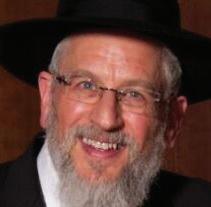
By Rabbi Zvi Teichman
For one thousand nine hundred and fifty-seven years we have been subjected to the galus, exile of Edom, often referred to as Rome. The Roman Empire, the physical and spiritual heir to its nefarious ancestor Esav, carried his ignoble mission to seek the eradication of his arch enemy, Yaakov and his progeny.
The world as we know it, particularly western culture, is a product of the influences that stemmed from that period of history and on.
We were indeed forewarned very early in our history that we would need to avoid the grip of this enemy.
םכל בר — Enough of your circling this mountain; turn yourselves הנופצ — northward. (ב ב םירבד)
The simple reading of the verse refers to G-d instructing the Children of Israel to avoid forcibly traversing through the lands of Seir/Edom, as it was ‘off limits’ to them as it was promised to Esav as an inheritance.
The Midrash (וט א ר"בד) understands this in a more literal and prophetic sense, with the verse asserting: םכל 'בר', there will elapse a ‘long time’ of history before we will be allowed to overpower and finally take this nation to judgment for all its hateful acts they perpetrated against us. Until such time we will have to suffer helplessly at their hands turning הנופצ , hiding from them, with the root of this word ןפצ, implying concealment (רקי ילכ)
Why are we still suffering in the hands of the descendants of Esav in this the longest of exiles.
By what merit did they deserve to continue to exert their might and control over the Chosen Nation?
King David in Psalms bemoans the fate of our galus exclaiming: ומקשתו You made them drink, שילשתועמדב — tears in great measure. (ו"פ םילהת)
The word שילש is used in the context of a large volume, a ‘third’ of a very large measure of tears.
Rashi, quoting a Midrash, interprets the word שילש in its relationship to שלש, three, and referring to a flow of three tears that emanated from the eyes of Esav upon his discovery that his brother snatched the blessings from him, leaving him empty handed. Esav gives out a great cry of pain and frustration, he cried out an exceedingly great, הרמו — and bitter cry, with the Torah intimating a triple aspect of tears. (דל זכ תישארב),
The Midrash elucidates that one tear exited his right eye, the second his left eye, and the third he stifled not allowing it to drop, for were it to descend we would never be able to ever leave his clutches. (םש בוט רחוש שרדמ)
The Zohar states that until we counter the tears of Esav with our own tears, the redemption will be withheld. (תשרפ תומש)
Have we not cried enough? Is the pain of thousands of years of persecution, displacement and suffering insufficient? Have the tears of the victims of war and terror; those suffering illness; people struggling with abuse, emotional strife, and poverty — whose sincere cries surely ascend to the loftiest realms of Heaven — not countered a thousandfold the crocodile tears of Esav?
Why does one hold back tears? Is it pride and the unwillingness to show vulnerability that keeps us from openly showing emotion and submitting to the moment?
Esav was aware that all his future success is in the hands of the Creator, as he was lovingly taught by his dear father. He knew the blessings lay in the hands of his father Yitzchak, who was entrusted by the Almighty alone. Even the mighty and arrogant Esav, who would never succumb to defeat, had no choice but to explode with emotion, exposing his awareness of the reality of the situation, that without a conduit of blessing through his father, he is doomed.
At that delicate moment a tinge of guilt begins to creep into Esav’s consciousness. He begins to ponder that perhaps he has lapsed in his responsibility to the Almighty. Maybe it’s not enough to simply attribute to G-d His full control of the universe, one
must submit oneself to Him. For a very brief moment he became mindful that therein lays man’s happiness.
With both of his eyes blurred and his vision of greatness for himself now dimmed, a tear of regret, of remorse, of longing for a true connection to G-d and a life that is filled with purpose and direction, starts to advance. But he catches himself, swiftly quashing that fleeting second of inspiration, regaining his composure with a conceit that is so much more comfortable and familiar, unwilling to surrender before G-d. The consequences for Esav are too great to trade in for the unknown, although he instinctively knows wherein lies the truth.
The third tear that stems from our inner eye of understanding, that doesn’t cloud our perception, but on the contrary, one that brings understanding and clarity to our consciousness to a more focused vision of what is true and real, was suppressed by Esav. If he would have permitted himself to be vulnerable, who knows what the outcome may have been.
We too, are often guilty of emulating the tears of Esav.
Our vista, however, is widened, we want health so we may perform mitzvos, we desire sustenance so we can pray and learn. We pine for peace so we can thrive as a society, and we cry earnest and painful tears of frustration that it is not yet, within our grasp. But the question remains. Where is our ‘third tear’? Are we equally defeated by the notion that we lack a meaningful relationship with G-d? Are we only concerned about our ‘dues’, and are only willing to pay allegiance so that we may be the beneficiaries of His blessing?
Permitting that third pristine tear to drop is testament to our frustration that we are unable to sense that deeper connection. We must let down our defenses in an honest expression of submission, allowing G-d to permeate our lives.
HaRav Elyashiv Zt”l, comments on a prayer we recite each Tisha B’Av at Mincha.
ןויצ— Zion, הכבתרמב — weeps bitterly,
— and Jerusalem raises her voice.
Jerusalem exclaims its pain loudly, yet Zion cries bitterly to itself.
Jerusalem represents the glory days of our nation. When the Temple stood, the king reigned in its capital, the Sanhedrin sat in judgment, we flourished as a nation and were at peace with our neighbors.
Everyone can identify with the sense of despair and longing we have for those better times.
But ןויצ, refers to the
, the gates that were distinguished by Torah and the inspired
life they lead. ןויצ, means a marker, a signpost, an indication that what we see down here on earth is merely an indicator of the Jerusalem on high, and a reflection of something so much more profound.
How many of us cry to attain that level of closeness with G-d? Where in our daily lives do we exert efforts that express the pining to cleave to Him?
Zion cries in bitter silence, because there aren’t many who understand its appeal, there are too few who appreciate that goal.
This Rav Elyashiv explains is the deeper meaning behind that famous episode with Rabbi Akiva and his colleagues. They observe a fox prancing through the desolate Temple Mount in fulfillment of the dreaded prophecy of Uriah who proclaimed that there would come a time when ןויצ — Zion will be plowed as a field They cry bitterly Rabbi Akiva laughs for he sees this prophecy’s realization as a portent for the prophecy of Zechariah to come true, There shall yet old men and old women sit in the broad places of Jerusalem. (ד ח הירכז)
Rabbi Akiva discovers that they indeed did cry that ‘third tear’ for the lonely Zion, that intense longing for a constant cleaving to G-d that will accompany their every moment. Only then can we eradicate the tears of Esav and achieve the glory of Jerusalem again.
The stifled הרמו — the bitter cry of Esav, can only be eclipsed by הכבת רמב — the heartfelt bitter cry of Zion as felt by our people.
It isn’t easy to relinquish our lives totally to a consciousness of G-d in every fiber of our existence. It takes much effort to achieve that level of closeness. But it is a goal we must strive for, an objective we must cry for. The frustrated tears that unabashedly flow down our face, expressing a deep pining for that relationship, are the only ones that will release us from this long galus
We often hold back because we feel unworthy. At times it is the fear of giving up our creature comforts and limited self-expectation that suppresses us from reaching for greatness. It is time to look deep within ourselves and release that bitter cry of yearning that is buried beneath each one of us.
This Tisha B’Av may we hold our tears back no longer, permitting ourselves to emote our genuine desire to restore the sense of love we have lost.
When G-d will sense that sincere expression of longing, He will release Himself from His frustrated concealment from us and bring us joyously together once again.
You may reach the author at: Ravzt@ ohelmoshebaltimore.com
Moshe begins the repetition of the Torah and provides subtle rebuke to the Jewish people for their previous sins. He recalls the nation’s traveling by the land of Edom, Moav, and Amon. He recounts the wars with Sichon and Og. He remembers the allocation of land to the tribes of Reuven, Gad, and half of Menashe, as well as the instructions for battle with Cana’an.
There is no room for G-d in the man who is filled with himself.
Inspiration Everywhere


-Baal Shem Tov
The gematria of הלא , the first word of Devarim - which is always read before Tisha Beav - is the same as הכיא . This word can also be read "Ayeka" - where are you?
The Bering Strait is a narrow and shallow waterway – about 85 kilometers (53 miles) wide and 40 meters (130 feet) deep – that separates Russia and Alaska and connects the Pacific and Arctic oceans. The closest point between Russia and Alaska (United States) are the two Diomede Islands.
Big Diomede Island (Russia) is only 3.75 kilometers (2.33 miles) west of Little Diomede Island (United States! These two islands are also separated by the International Date Line. The International Date Line is a line that cuts a path across the Pacific Ocean, marking where one day ends and another begins.
Big Diomede and Little Diomede are so close that in the winter, when the water freezes, it is possible to walk from the United States to Russia on the ice (although, it is illegal!). While there is barely a population on these two islands, Big Diomede has an important weather station on it, and Little Diomede is inhabited by a small group of seafarers, known as the Chukchi people.
Because of the proximity of these two islands and the placement of the International Date Line between them, a tremendously ironic situation occurs. As you are standing on the shore of Little Diomede looking over at Big Diomede, you are not only looking into another country, but you are looking into another time zone, a time zone that is 20 hours ahead! That means, on a clear day, you can see tomorrow, today!
What a powerful imagery! The ability to see tomorrow, today, is such a deeply profound and inspirational reality.
My friends, we are currently in the period of The Three Weeks, just a few days away from Tisha Be’av. The Shabbos before the Ninth of Av is called Shabbos Chazon –“Shabbos of Vision” – named after the opening words of the day’s reading from the Haftora (Isaiah 1:1-27).
So, it is true, unless Moshiach arrives in time, we will experience the sadness of Tisha Be’av and mourn over the loss of the Bais Hamikdash and the fact that it is still not rebuilt today, in the present.
Words - 1,548 PARSHA STATS
Letters - 5,972
Mitzvos - 2
Reb Nosson of Breslev (see Likutei Halachos
highlights that it’s not a coincidence that we read Parshas Devarim before Tisha Be’av. The entirety of the parshah deals with our journey to Eretz Yisroel and the struggles that we had – with our Emunah –along the way.
If we wish to get back to Eretz Yisroel, we need to work on this inyan...Emunah in Hashem!
Chazal arranged the Torah readings so that Moshe’s rebuke in Devarim would always be read during the Nine Days. Interestingly, in Devarim 1:12, Moshe says: “How can I alone bear your trouble...” – ידבל אשא
That word, הכיא (Eicha) is the same word that begins Megilas Eicha!

The point of the mussar of Moshe, through the words הלא ... was for the Jewish people to find their true holy selves.
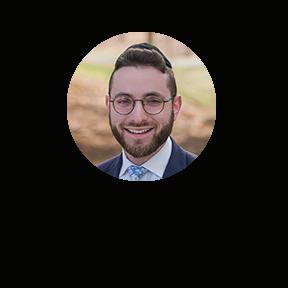
Rabbi Ori Strum is the author of “Ready. Set. Grow.” “Dove Tales,” and “Karpas: The Big Dipper.”
His shiurim and other Jewish content can be found on Torah Anytime and Meaningful Minute. He may be reached at 443-938-0822 or rabbistrumo@gmail.com
But, at the same time, while we are mourning today, we have not given up hope on what is to come. We are hopeful and yearning for the rebuilding of the Third Bais Hamikdash, may it be soon!


As yidden, we are gifted with a spiritual sense of vision. Through our mourning ( לבאתמה לכ ) over the destruction, we are given the clarity to see the joy of its construction (

). The Kedushas Levi says that right now
– amidst the mourning of today, we can see the joy of what will be in the future.
A yid is given a special gift of vision, which allows him to look out and see tomorrow, today!


The book of Devarim was spoken by Moshe Rabbeinu in the last 5 weeks of his life. He began his “final address” with rebuke to the people, albeit veiled/subtle rebuke. Why did Moshe feel it important enough to a) rebuke the people, and b) to do it in a veiled manner?
What lesson can we learn from here?
Mercaz Torah U’Tefillah: EVERY 15 MINUTES
M-F: 6:15 AM, S-F: 6:30 AM, 6:45 AM, 7:00 AM, 7:15 AM, 7:30 AM, 7:45 AM, 8:00 AM, 8:15 AM, 8:30 AM, 8:45 AM, 9:00AM, 9:15AM, 9:30AM, 9:45AM, 10:00AM
Neitz Beit Yaakov [Sefaradi] M-F
Ohel Yakov S-F
6:00 AM Shomrei Emunah Congregation M-F
6:10 AM Agudath Israel of Baltimore M, Th
6:15 AM Kol Torah M, TH
Shearith Israel Congregation M, TH
6:20 AM Agudah of Greenspring M, TH
Agudath Israel of Baltimore S, T, W, F
Arugas HaBosem (Rabbi Taub's) S-F
Bnai Jacob Shaarei Zion Congregation M-F
Kehilath B'nai Torah M, TH
Pikesville Jewish CongregationM, TH
Shomrei Emunah CongregationS, M, TH
6:30 AM Agudah of Greenspring T, W, F
Chabad of Park Heights M-F
Darchei Tzedek M-F
Kehilath B'nai Torah T, W, F
Khal Bais Nosson M-F
Khal Ahavas Yisroel/ Tzemach Tzedek M-F
Kol Torah T, W, F
Ohr Yisroel M-F
Pikesville Jewish CongregationT, W, F
Shearith Israel Congregation T, W, F
Shomrei Emunah CongregationT, W, F
6:35 AM Aish Kodesh (downstairs Minyan)M, TH
Ohel Moshe M, TH
6:40 AM Aish Kodesh (downstairs Minyan)T, W, F
Bnai Jacob Shaarei Zion CongregationM, TH
6:45 AM B”H and Mesivta of Baltimore (Dirshu Minyan) S-F
Beth Abraham M, TH
Greenspring Sephardic Synagogue M-F
Ner Tamid M-F
Ohel Moshe
T, W, F
Suburban Orthodox Congregation Toras Chaim M-F
The Adas: Chofetz Chaim Adas Bnei IsraelM, TH
6:50 AM Agudath Israel of Baltimore M, TH
Ahavat Shalom [Sefaradi] M, TH
Bais Medrash of Ranchleigh M, TH
Bnai Jacob Shaarei Zion CongregationT, W, F
Community Kollel Tiferes Moshe Aryeh M, TH Derech Chaim M-F
Kol Torah M-F
Ohel Moshe S
Ohr Hamizrach [Sefaradi] M, TH
Shomrei Emunah CongregationM, TH
The Shul at the Lubavitch CenterM, TH
6:55 AM Beth Abraham T, W, F
Kol Torah M, TH
The Adas: Chofetz Chaim Adas Bnei IsraelT, W, F
7:00 AM Aish Kodesh (upstairs Minyan) M-F
Agudath Israel of Baltimore S, T, W, F Ahavat Shalom [Sefaradi] T, W, F
Arugas HaBosem (Rabbi Taub's)S
Bais Medrash of Ranchleigh T, W, F
Community Kollel Tiferes Moshe Aryeh T, W, F Greenspring Sephardic Synagogue S Khal Ahavas Yisroel/ Tzemach TzedekS
Kol Torah T, W, F
Moses Montefiore Anshe Emunah M-F
Ohr Hamizrach [Sefaradi] S, T, W, F
Shearith Israel Congregation S, M, TH Shomrei Emunah CongregationT, W, F
Shomrei Mishmeres Hakodesh M-F
The Shul at the Lubavitch CenterT, W, F Tiferes Yisroel M-F
7:05 AM Machzikei Torah (Sternhill's) M, TH
7:15 AM Kedushas Yisrael S Kol Torah S
Machzikei Torah (Sternhill's) S, T, W, F
Ner Israel Rabbinical College S-F
Shearith Israel Congregation T, W, F
Shomrei Emunah CongregationS
Suburban Orthodox Congregation Toras Chaim S
The Adas: Chofetz Chaim Adas Bnei IsraelS
Tzeirei Anash M-F
7:20 AM Agudath Israel of Baltimore M, TH
Beth Tfiloh Congregation M-F
Kol Torah M-F
Ohr Hamizrach [Sefaradi] M, TH
Shomrei Emunah CongregationM, TH
7:30 AM Agudah of Greenspring S
Agudath Israel of Baltimore S, T, W, F
Ahavat Shalom [Sefaradi] S
Bais Haknesses Ohr HaChaim S-F
Bais Hamedrash and Mesivta of Baltimore S-F
Bais Medrash of Ranchleigh S
Beit Yaakov [Sefaradi] S
Bnai Jacob Shaarei Zion CongregationS
Chabad of Park Heights S
Community Kollel Tiferes Moshe AryehS-F
Darchei Tzedek S
Kedushas Yisrael S-F
Khal Bais Nosson S
Ner Israel Rabbinical College (Mechina) S-F
Ohr Hamizrach [Sefaradi] S, T, W, F
Shomrei Emunah CongregationT, W, F
7:45 AM Bnai Jacob Shaarei Zion Congregation M-F
Talmudical Academy S-F
Darchei Tzedek M-F
Mesivta Kesser Torah S-F
Mesivta Shaarei Chaim S-F
Yeshivas Torah Simcha (school days only) S-F
7:50 AM Derech Chaim S
Ner Tamid S
Ohel Moshe M-F
8:00 AM Agudath Israel of Baltimore S-F
Beth Abraham S
Chabad Israeli Center M-F
Darchei Tzedek S
Khal Ahavas Yisroel/ Tzemach TzedekS
Kehillas Meor HaTorah S
Ohr Yisroel S
Pikesville Jewish CongregationS
Shearith Israel Congregation S
Shomrei Emunah Congregation S-F
The Shul at the Lubavitch CenterS
Tiferes Yisroel S
Tzeirei Anash S
Yeshiva Tiferes Hatorah S-F
8:15 AM Kehilath B'nai Torah S
Kol Torah S
8:20 AM Bais Haknesses Ohr HaChaim S-F
8:25 AM Ohr Chadash Academy (School Days Only) S-F
8:30 AM Agudath Israel of Baltimore S-F
Chabad Israeli Center S
Machzikei Torah (Sternhill's) S-F
Ohel Moshe S
Ohr Hamizrach [Sefaradi] S
Shomrei Emunah Congregation S-F
Shomrei Mishmeres HakodeshS
9:00 AM Aish Kodesh S
Agudath Israel of Baltimore S-F
Bais Haknesses Ohr HaChaim S
Beth Tfiloh Congregation S
Bnai Jacob Shaarei Zion CongregationS
Moses Montefiore Anshe EmunahS
Shomrei Emunah Congregation S-F
Suburban Orthodox Congregation Toras Chaim S-F
Mincha Gedolah Mercaz Torah U’Tefillah
Khal Ahavas Yisroel/Tzemach Tzedek
1:45 PM Yeshivas Torah Simcha (school days only) M-Th
Reischer Minyan - 23 Walker Ave 2nd Floor 10055 Red Run Blvd Suite 295
2:15 PM Pikesville Beis Medrash - 15 Walker Ave
2:30 PM Bais Medrash of Ranchleigh
Community Kollel Tiferes Moshe Aryeh
Tov Pizza Mincha Minyan
Ner Israel Rabbinical College
Mesivta Shaarei Chaim (Community Kollel)
Shearith Israel Congregation
2:45 PM Kollel of Greenspring
Shearith Israel Congregation (S-Th)
3:00 PM Agudath Israel of Baltimore (S-F)
Bais Haknesses Ohr HaChaim
Mercaz Torah U'Tefillah
3:05 PM Kedushas Yisrael
3:15 PM Hat Box
3:22 PM Ohr Chadash Academy (School Days Only, Call to Confirm)
3:30 PM Mercaz Torah U’Tefillah
4:00 PM Agudath Israel of Baltimore (S-Th) Mercaz Torah U'Tefillah
4:30 PM Mercaz Torah U’Tefillah
5:00 PM Agudath Israel of Baltimore (S-F) Mercaz Torah U’Tefillah
5:30 PM Agudath Israel of Baltimore (S-Th) Mercaz Torah U’Tefillah
6:00 PM Agudath Israel of Baltimore (S-F)
Mercaz Torah U’Tefillah
Shearith Israel Congregation (S-Th)
6:30 PM Agudath Israel of Baltimore (S-Th)
Mercaz Torah U’Tefillah
10 Min Before ShkiAh Chabad Israeli Center
14 Min Before ShkiAh Kol Torah
Plag
continued
9:00 PM Agudath Israel of Baltimore
Arugas Habosem
Shomrei Emunah Congregation
Suburban Orthodox Congregation Toras Chaim
9:20 PM Kol Torah
9:30 PM Agudah of Greenspring
Agudath Israel of Baltimore
Kedushas Yisrael
9:40 PM Ahavat Shalom [Sefaradi]
9:45 PM Bais Haknesses Ohr HaChaim
Kollel Erev Birchas Yitzchok (Luries)
Kollel of Greenspring
Machzikei Torah (Sternhill's)
Ohr Hamizrach [Sefaradi]
Yeshiva Tiferes Hatorah
9:50 PM Aish Kodesh
Community Kollel Tiferes Moshe Aryeh
Ohel Moshe
10:00 PM Agudath Israel of Baltimore
Darchei Tzedek
Kehilath B'nai Torah
Khal Ahavas Yisroel/ Tzemach Tzedek
Shearith Israel Congregation
Shomrei Emunah Congregation
10:05 PM Kol Torah
10:10 PM Ner Israel Rabbinical College
10:15 PM Derech Chaim
Khal Bais Nosson
10:30 PM Agudath Israel of Baltimore
11:00 PM Agudath Israel of Baltimore
11:30 PM Agudath Israel of Baltimore
Agudah of Greenspring - 6107 Greenspring Ave
Agudath Israel of Baltimore - 6200 Park Heights Ave
Ahavat Shalom - 3009 Northbrook Rd
Ohel Yaakov
Shomrei Emunah Congregation
Suburban Orthodox Congregation Toras Chaim
Aish Kodesh
Agudath Israel of Baltimore
Agudah of Greenspring
Bais Haknesses Ohr HaChaim
Beth Abraham
Before Shkiah
Bnai Jacob Shaarei Zion Congregation
Darchei Tzedek
Kehillas Meor HaTorah
Kehilath B’nai Torah
Khal Ahavas Yisroel/ Tzemach Tzedek
Khal Bais Nosson
Machzikei Torah (Sternhill’s)
Mercaz Torah U’Tefillah
Ner Tamid
Ohel Moshe
Ohr Hamizrach [Sefaradi]
Ohr Yisroel
Pikesville Jewish Congregation
Shearith Israel Congregation
Shomrei Emunah Congregation
Shomrei Mishmeres
Suburban Orthodox Congregation Toras Chaim
The Adas: Chofetz Chaim Adas Bnei Israel
The Shul at the Lubavitch Center
Tiferes Yisroel
Mercaz Torah U’Tefillah: EVERY 15 MINUTES
8:15 PM, 8:30 PM, 8:45 PM, 9:00 PM, 9:15
PM Agudath Israel of Baltimore
8:00
8:30 PM Agudath Israel of Baltimore
1:50 PM Ohel Moshe
1 South Street, 27th Floor.
2:00
PM Agudath Israel of Baltimore (S-F)
Big Al @ The Knish Shop Party Room
Kol Torah
For edits, additions, or sponsorships, email ads@baltimorejewishhome.com
Market Maven
8:45 PM Darchei Tzedek
Ner Israel Rabbinical College (Mechina)
Ohr Yisroel
8:50 PM Mesivta Shaarei Chaim (Etz Chaim Building)
8:55 PM Community Kollel Tiferes Moshe Aryeh
Aish Kodesh - 6207 Ivymount Rd
Arugas HaBosem - 3509 Clarks Ln
Bais Dovid-Bais Medrash of Summit Park- 6800 Sylvale Ct
Bais Haknesses Ohr HaChaim - 3120 Clarks Ln
Bais Hamedrash and Mesivta of Baltimore - 6823 Old Pimlico Rd
Bais Medrash of Ranchleigh - 6618 Deancroft Rd
Beit Yaakov - 3615 Seven Mile Ln
Beth Abraham - 6208 Wallis Ave
Beth Tfiloh Congregation - 3300 Old Court Rd
Bnai Jacob Shaarei Zion Congregation - 6602 Park Heights Ave
Chabad Israeli Center - 7807 Seven Mile Ln
Chabad of Park Heights - 3402 Clarks Ln
Community Kollel Tiferes Moshe Aryeh - 3800 Labyrinth Rd
Darchei Tzedek - 3201 Seven Mile Ln
Derech Chaim - 6603 Pimlico Road
Greenspring Sephardic Synagogue 6611 Greenspring Ave.
Kedushas Yisrael - 6004 Park Heights Ave
Kehilath B’nai Torah - 6301 Green Meadow Pkwy
Kehillas Meor HaTorah - 6539 Pebble Brooke Rd
Khal Ahavas Yisroel/ Tzemach Tzedek - 6811 Park Heights Ave
Khal Bais Nosson - 2901 Taney Rd
Kol Torah - 2929 Fallstaff Rd
Kollel of Greenspring - 6504 Greenspring Ave.
Machzikei Torah - 6216 Biltmore Ave
Mercaz Torah U’Tefillah - 6500 Baythorne Rd
Mesivta Kesser Torah - 8400 Park Heights Ave
Mesivta Shaarei Chaim - 3800 Labyrinth Rd
Moses Montefiore Anshe Emunah - 7000 Rockland Hills Dr
Neuberger, Quinn, Gielen, Rubin & Gibber One South Street, 27th Floor
Ner Israel Rabbinical College - 400 Mt Wilson Ln
Ner Tamid - 6214 Pimlico Road
Ohel Moshe - 2808 Smith Ave
Ohel Yakov - 3200 Glen Ave
Ohr Chadash Academy - 7310 Park Heights Avenue
Ohr Hamizrach [Sefaradi] - 6813 Park Heights Ave
Ohr Yisroel - 2429 Lightfoot Dr
Pikesville Jewish Congregation - 7644 Carla Rd
Shearith Israel Congregation - 5835 Park Heights Ave
Shomrei Emunah Congregation - 6221 Greenspring Ave
Shomrei Mishmeres Hakodesh - 2821 W Strathmore Ave
Suburban Orthodox Congregation Toras Chaim - 7504 Seven Mile Ln
Talmudical Academy - 4445 Old Court Rd
The Adas: Chofetz Chaim Adas Bnei Israel - 5915 Park Heights Ave
The Shul at the Lubavitch Center - 6701 Old Pimlico Rd
Tiferes Yisroel - 6201 Park Heights Ave
Tzeirei Anash - 6706 Cross County Blvd
Wealcatch Insurance - 37 Walker Ave 2nd floor
Yeshiva Tiferes Hatorah - 6819 Williamson Ave
Yeshivas Toras Simcha- 110 Sudbrook Ln.
By t ammy m ark
Holocaust survivor Emil Fish’s life story can fill volumes – from his childhood in Slovakia to his liberation from Bergen-Belsen, from immigration to Israel and Canada to building and living the “American Dream” in California.
Fish is a father and a philanthropist, an entrepreneur and an educator. He’s spent the last 20 years rejuvenating his birthplace of Bardejov in efforts to preserve its Jewish history, while ardently working to expand Holocaust education in the U.S. and abroad. In a somewhat unexpected turn, nonagenarian Fish recently added a new title to his extensive resume: movie producer for the film Bardejov.
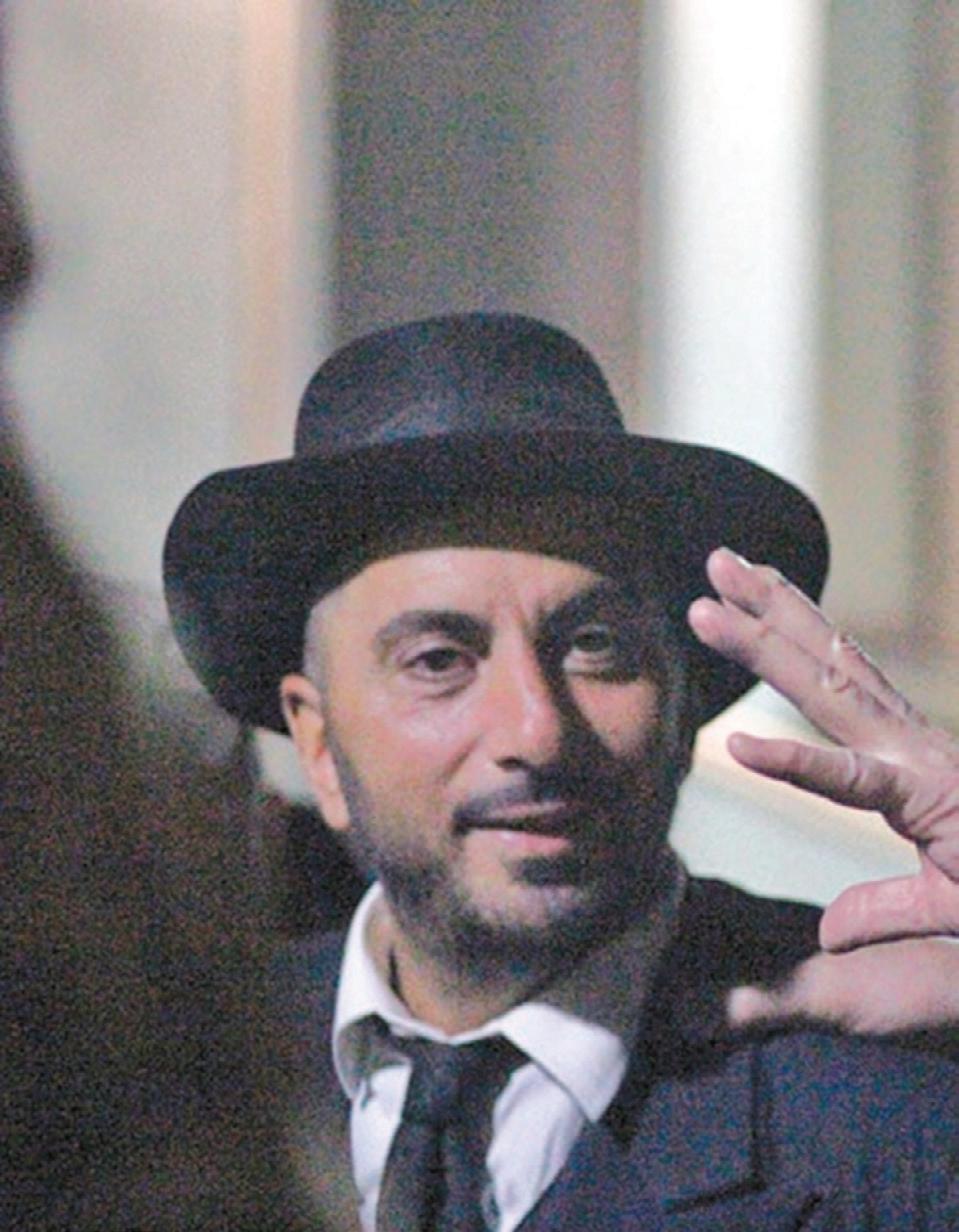
Bardejov follows the story of Rafuel Lowy, a successful businessman and president of the Bardejov Jewish Community of North-Eastern Slovakia, during World War II. Lowy and the other leaders displayed composure and bravery as the government took over the Jewish businesses – and eventually their freedoms. To the G-d-fearing non-violent Jews of Bardejov, obedience had thus far seemed safer than resistance.
In March of 1942, the community received orders from the Hlinka Guard – the Slovakian Nazi collaborators – to assemble all healthy Jewish girls, without exception, for transport to work in a shoe factory. The command comes right before Purim; Lowy instructed the Jews to fast, pray and believe in the possibility of a miraculous, dramatic salvation.
Compliance was again determined to be the only choice, until community leaders uncovered the truth – their girls were in
actuality bound for Auschwitz. A risky but ingenious plan was then devised: infect the girls with typhus to force a quarantine and circumvent the orders.
Though Fish himself was just a young boy at the time, his parents were community leaders involved in the rescue mission and are portrayed in the film. Fish explains that the tale is just one story from one town, that there were so many heroic stories to be told from that period of time.
“It’s only an example of what Bardejov was all about,” the 90-year-old shares.
“I didn’t just wake up and say I want to be a movie producer!” Fish says. “The film is a coincidence. It’s just a result of my 20 years of work. The film is one percent of the whole story.“
Fish exudes enthusiasm, tenacity and faith. Undeterred by challenging situations or challenging people and unafraid of hard work in all endeavors, he also manages to make friends along the way.

The idea for the film began three years prior. Fish knew it was a compelling story and was looking for someone to tell it. He connected with Rabbi Shmuel Lynn, director of the kiruv organization Olami Manhattan and a former screenwriter, to write the story. Fish then began the search for a filmmaker to produce the movie, without having the typically large budget needed for production. Fish couldn’t find the right fit for his important project – that is, until a seatmate on an airplane flight struck up a casual conversation.
The seatmate was Danny A. Abeckaser, the Israeli-born American actor, director and filmmaker who specializes in making impactful movies on smaller budgets. Fish told him a little bit about his life’s work and how he had been looking to make a Holocaust movie. Abeckaser was intrigued.
Fish and Abeckaser soon got together and quickly developed a working relationship. Fish insisted that Abeckaser join him
on a visit to Bardejov before undertaking the project – Fish was passionate and persistent until Abeckaser agreed.
Fish recalls Abeckaser’s reaction, “He was blown away. He said, ‘We’ve got to make the movie!’”
Bardejov was shot primarily in Israel, with a day on location in Bardejov. Fish insisted on being on set throughout the filming, intending on being a bystander. With his devotion to his hometown and attachment to the story, Fish couldn’t help but get involved in the process, much to Abeckaser’s surprise.
“Danny is very good and passionate! Then I also took a personal interest in every actor, so that they should know what they’re doing,” he says.
Fish spent time with lead actor Robert Davi, who portrayed Lowy, and the rest of the cast to enlighten them as much as he could about the town, the people, and the surrounding history. He made sure the
wardrobe was historically and culturally accurate – particularly when he noticed a missing kippah or an extra wearing a miniskirt. Fish’s valuable notes were ultimately incorporated into the production.
With the help of screenwriter Kosta Kondilopoulos and executive producer Yoav Gross, the story of Emil’s beloved Bardejov came to life, with Bardejov released on Amazon Prime in 2024. Abeckaser and Fish appeared in the movie as well, with Fish in the introduction, and the men went on to work together on other projects.
“We became good friends, real close friends,” shares Fish.
The sentiment is absolutely mutual for Abeckaser.
“I love that man. I just love everything he stands for and everything he does,” says Abeckaser of Fish.
Abeckaser explains that he was busy with other projects at that time, but he went into deep dive on perfecting the script after his visit to Bardejov. He really wanted people to understand the history.
“I told him I have to shoot in Israel…we need Jews to work on this,” he says.
Much of Abeckaser’s current work focuses on other significant true stories. Fresh off production of 12 Hours in October about the October 7 th attacks, Abeckaser is now again in Israel to begin filming the story of Israel’s successful “beeper” operation, titled Frequency of Fear
“Emil realized I knew what I was doing, and in the meantime, I ‘fell in love’ with him. He has such energy – he stays young and motivated. Just a good, good person,” shares Abeckaser. “He became a part of my life.”
Emil Fish was born to an Orthodox Chassidic family in Bardejov, a formerly idyllic Slovakian town two hours from the Polish border. The pre-war population numbers around 10,000 people including 3,000 Jews, 70 percent of whom were Orthodox. Most were Chassidim from Poland, who escaped during the decades of pogroms there. Fish’s grandfather was a Chassid from the B’nei Yissaschar sect in Poland, donning a long beard and a shtreimel. He came to Bardejov in 1900. He owned a small grocery store but was quite poor.
His son, Fish’s father Herman, decidedly did not want to live a life of poverty and refused to go to the Satmar yeshiva in the Carpathian Mountains as he was expected to, choosing instead to go to Breuer’s in Frankfut, where they allowed the yeshiva boys to study trade through
correspondence. He worked hard there and became both a big talmid chochom and a bookkeeper.
Herman Fish secured a job, married Leah Handler in 1930, and had two children, a daughter Ann and son Emil, who was born in 1935.
Emil was sent to cheder. Herman indeed went on to be a very successful businessman and one of the community leaders, thus enabling him to help his fellow Jews in Bardejov survive.
Adolf Hitler, ym”sh, and Jozef Tiso, president of the Slovak Republic, were allies. At the time, there were only two countries in Europe that were not occupied by the Germans: Italy and Slovakia. Slovakia was nonetheless very anti-Semitic. By the middle of 1942, there was an order to take 80% percent of the 80,000 Jews in Slovakia to Auschwitz and other concentration camps. They allowed a 20% exemption because Slovakia said they needed the successful Jews to stay – Fish’s family was part of that group. 80% of the 80% of Jews taken to Auschwitz did not survive the war.
The tale told in the Bardejov film took place before the order of the 80%.
“There was an initial order to send a thousand girls to work in a shoe factory. The leader, Mr. Lowy, found out that it was a lie; they were sending them to Auschwitz.” Through his research, Fish believes that this would have been the first official Jewish transport to Auschwitz.
“Between the years of 1942 and 1944, they left us alone to live in Slovakia – but we had to have yellow bands, we couldn’t go to public school or public spaces. It wasn’t normal, but they didn’t arrest anyone or send them to the concentration camps,” Fish recalls.
As the 20% of 3,000 Jews of Bardejov, approximately 600 people remained. In 1944, Tiso ordered all remaining Jews to relocate to another part of the country and subsequently issued orders to send the Jews to the concentration camps. Some tried to escape, some went into hiding in the forest, and most got caught. Lowy was taken to Auschwitz in 1944; he did not survive.
“I was nine years old, and I remember everything from the age of three. In my family, we have good memories,” Fish shares. “Everybody who survived had to have a gimmick or luck or did something in their lives – they had to survive. If you had nothing to eat, you’d have to steal bread to survive.”
Fish is very proud of his father’s shrewdness and bravery. He recalls an in-
cident when the family was trying to hide from authorities. They had stopped at a coffee shop where they had come face to face with a German officer; instead of staying quiet, Herman Fish spoke directly to him. Speaking in perfect German, he addressed the soldier, exchanging words and salutes as if he was a proud gentile Slovakian!
Herman Fish had certain connections, and the family was initially able to move around to avoid capture during the fall of 1944. They sought shelter in a gentile family’s home but were soon reported; the Slovakian Gestapo came and arrested them in the middle of the night. The Fish family was deported by train and sent to the concentration camps – Emil, his older sister Ann, and his mother Leah to Bergen-Belsen, and Herman to Buchenwald.
“We went to Bergen-Belsen. We came very late, and by that time there was not enough order in the concentration camp. We came out of the train, there were guards at the train, and it was midnight -- just like you see in the movies – with the lights and the dogs. They put us on a truck, and they let the family stay together in the barrack. Three people per bed. No food – maybe one piece of bread,” recalls Fish.
At first, they still had their suitcases with them, and while some people had prepared and brought provisions, within a few days everything was gone. There was hunger, and the situation quickly became dire. Bergen-Belsen was especially overcrowded. Illness spread easily, and people were dying on the streets.
Diarist Anne Frank was in the next block, with the other children from Holland. Both she and her sister Margot contracted typhus and died there in 1945. Fish’s sister Ann caught typhus as well. Those with typhus were separated from the others and left to die, but Emil bravely snuck out to visit his sister each day by the window – she ultimately survived.
In April 1945, Fish, his sister and his mother were liberated from Bergen-Belsen by the British Army. Unfortunately, many of the sick and starving survivors subsequently died from overfeeding.
Emil, Ann and Leah survived the Holocaust and made their way back to Bardejov. After an initial miscommunication that their father Herman had died, he, too, returned home and the family was reunited.
“We had a great life in 1945 – we had a business and food, and we went to school,” Fish share. “We knew there was going to be a State of Israel. The Israeli government
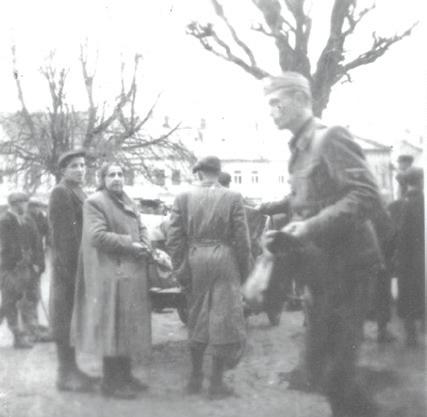
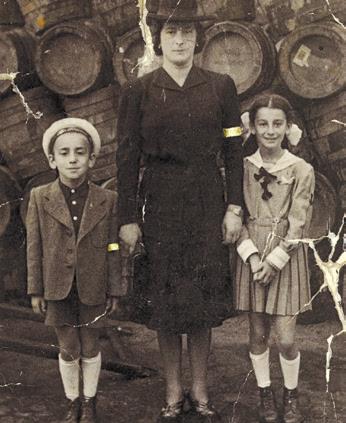

sent shlichim over, and we went to B’nei Akiva meetings where teachers taught about Zionism. There were only 30 kids in town so we all became close to each other, and we became Zionists.”
“In 1945-48, we knew there was going to be a State of Israel, but we didn’t know when. In 1948, the communist party won the election in Czechoslovakia. We knew that Jews and communism didn’t get along. Almost everybody left. I went to Israel without my parents – I didn’t want to wait.”
Emil Fish was only 14, but he told his
from the concentration camps, except for him,” Fish says. “All his brothers, uncles, grandfather – everybody was killed. On my mother’s side, almost everybody survived.”
Emil received an engineering degree at the University of Southern California. He met and married his wife Jenny Schiff, and together they raised children David, Jeffrey and Monique.
“I get married, I have three kids – and I live my American Dream,” he quips.
One might say he was living the Jewish American dream, as Fish gratefully
“I made a neder: they killed my family but they’re not going to take my heritage.”
father his plans and traveled to Bratislava to get himself a passport. He went off to Israel with B’nei Akiva, and spent two and a half years there immersed in the language and culture but without his family. Those early years in Israel were challenging, and he didn’t want his parents to have to struggle again after the war.
Everyone eventually left the town of Bardejov, and Fish’s family chose to immigrate to Canada in 1950. Herman then insisted that Emil join them in Canada, and as a minor, he was required to comply. In 1955, the family of four moved to America.
The Fish family landed in California, where Leah’s sizeable extended family had already settled years before and were prospering, working mainly in construction and movie production. Fish gratefully counts hundreds of cousins in the Los Angeles area, including the Spiegel family who helped establish the Yad Vashem Children’s Memorial in Jerusalem, in memory of their baby Uziel who was killed in the Holocaust.
“Nobody came back on my father’s side
recounts the privilege of being able to take his family away for Pesach and other vacations, going skiing in the winter, and serving as president of his community shul and school, Congregation Shaarei Tefila and Hillel Hebrew Academy, respectively.
With all that, something was missing from their lives, Fish explains.
“One day, my children said, ‘Everybody takes their kids on a heritage trip to Europe, and you never took us!’”
His reaction at the time was viscerally adamant against going.
“I said, ‘I’m not going back to Europe – under no condition am I going back to Europe! I will go back if you give me a plane to bomb Germany, then I’d be more than happy to go. Otherwise, I’m staying right here where I am.’”
Fish’s children persisted, insisting that they wanted to know where they came from. After two months of pleading, he changed his mind; in July 2005,
Emil Fish returned to Bardejov for the first time since 1949.
By this time there were no Jews left in Bardejov, as the last remaining survivor had recently died. Fish had made advance arrangements to see his hometown. When the designated tour guide came to greet the Fish family, he announced that the mayor wanted to see them. When they arrived at the city hall, they were warmly welcomed, and Jenny was presented with flowers.
While they outwardly looked like tourists, Fish made sure to clarify to the mayor, “I just came home. Don’t think of me as American. I came home.”
This initial homecoming tour was far from complete; though much of the town had been restored to its beauty since the war, the Jewish sites of Bardejov were neglected. Fish couldn’t get inside to see his childhood shul or his grandfather’s home. Other main Jewish sites, including a yeshiva and a mikveh, were preserved and still intact, although in poor shape. The cemetery was overgrown with weeds. One shul called Bikur Cholim was saved by a non-Jewish neighbor who would not let the Germans enter it.
Fish says, “A gentile woman, who lived next door to the shul where I was bar mitzvah, would not let anyone go in there, and the shul stayed intact the way it was built – unbelievable.”
Fish couldn’t get inside the shul – nobody had the key. As a home builder, Fish insisted he would somehow find an opening, and sure enough, he did.
“It was the way I left it in ‘49. Even the siddurim were there. Can you believe it? She saved the shul – she wouldn’t let the Germans or the Hlinka Slovakian police in.”
Fish promised to go back with better arrangements, and indeed returned the following year. He was able to visit the home
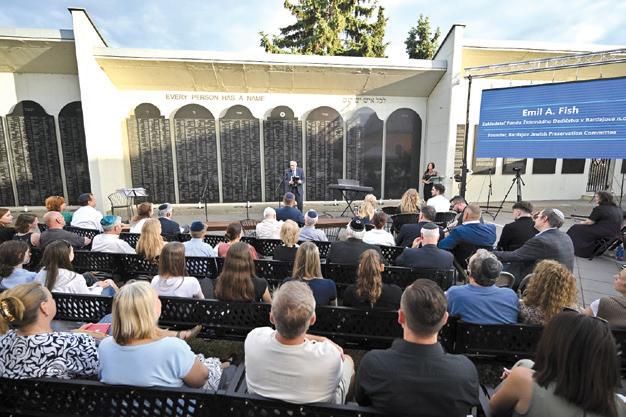
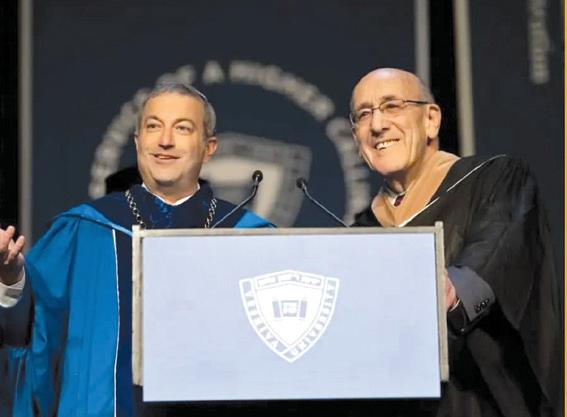
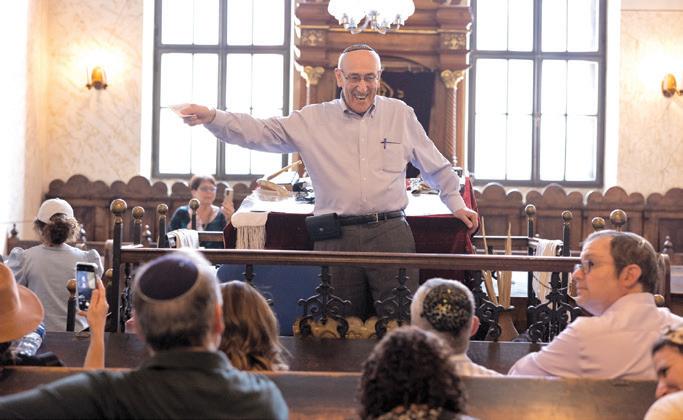
he was born in and even befriended the current owners. Still, Fish was disheartened to see his shul used as a storage area for a hardware store.
Standing in front of his old cheder and seeing it in such disarray, Fish took a personal vow.
“I made a neder: they killed my family but they’re not going to take my heritage! I’m going to fix these buildings. I’m an engineer. I don’t care if there are no Jews here. I owe something to my father’s family to save their heritage – and that’s what I did.”
Fish learned that in November 2000, Bardejov had been selected by UNESCO as a World Heritage Site, recognized for its “Jewish suburbia and historic town center” – this gave him hope. Fish went on to develop a longstanding relationship with the mayor and the Bardejov officials throughout the years.
In 2006, Fish founded the Bardejov Jewish Preservation Committee and truly invested himself, and his own funds, in his noble mission. Fish began going through various channels in attempts to make things happen. Many of the people he dealt with in Bardejov had Jewish family names but weren’t Jewish. It seems that many Jewish men remained in Europe and eventually intermarried and were now controlling the Jewish heritage sites. Fish accepted that it was not going to be an easy process, but he was determined – and determined to do things his way, not to be taken advantage of.
Fish went back and forth with contacts in both Europe and in the United States –ambassadors, members of Congress – but nobody would help him. After five years of efforts, visiting Bardejov and meeting with the committee every few months, Fish didn’t see any significant progress. Undeterred, Fish informed the mayor that he wanted to build a memorial and insisted
that he should provide the land for free –boldly positing that the land belonged to his grandfather and was left by the communists when they gave up. It was three years later when the mayor called up Fish, seemingly out of the blue, and finally agreed to allocate the land to the project.
Construction of the Bardejov Holocaust Memorial began in March 2013. During this time, Fish also was able to work on a memorial book to help celebrate and honor the formerly vibrant Jewish community. The Memorial Book of Jew-
of the distinguished graduate schools under the YU name. Feeling strongly about the vital need for an increase in formal Holocaust education, Fish met with President Rabbi Dr. Ari Berman to discuss a proposal and plan a curriculum.
In 2019, Yeshiva University’s Emil A. and Jenny Fish Center for Holocaust & Genocide Studies was established. Under direction of Dr. Shay Pilnik, the center’s mission is to train the future generations of educators and leaders in Holocaust education, a crucial undertaking in these cur-
“This person is different than you, but there’s one thing in common: you’re Jews.”
ish Bardejov features photographs and historical information depicting generations of Jewish life before the war, along with a comprehensive registry of families of the region who perished during the Holocaust. A formal dedication ceremony for the Bardejov Holocaust Memorial was held on June 24, 2014, with Fish delivering the opening remarks. A commemoration is now held annually in June.
Fish was gratified to see his personal vow now coming to fruition. A few years after the memorial project, Fish discovered that as a “new democracy,” the Slovakian government had received a foreign grant to build up the town. This enabled the Bardejov Jewish Preservation Committee to rebuild the main synagogue, and they are now constructing a museum, among other developments.
For Fish, there was still more to be done. When his grandson Zachary graduated from Yeshiva University High School in 2017, Fish took notice of all
rently challenging times. Fish’s daughter Monique Mogyoros received a Master’s degree through the program and became an adjunct professor teaching Holocaust studies, while Emil Fish received an honorary doctorate from YU.
Fish currently spends time between Los Angeles, New York and Philadelphia, where his daughter lives, having moved there prior to Jenny’s passing in 2020. He recently remarried Esther Muller. He is very grateful to have 12 Torah-observant grandchildren and to be celebrating family milestones.
“I have a simple principle in life – G-d is good to me,” he shares.
The Bardejov film provides a perspective on how Emil Fish and his ancestors approached life and its challenges. The Jews of Bardejov embodied the values of unity, faith and prayer; the tenets of emunah and bitachon were integral to their strength and survival. Their stories exemplify the concept of making a plan, working hard – and turning to G-d.
Fish recently returned from Bardejov after attending the 2025 Holocaust Commemoration, a smaller yet particularly meaningful event, as it fell during Israel’s 12 Day War. He spends time traveling the world to share his personal experiences, as well as focusing efforts on expanding Holocaust education. Fish firmly believes there should be increased support for Holocaust studies across all spectrums of the Jewish community and feels that awareness was waning before the October 7 th attacks.
“I’ve been to Dubai, I’ve been to Rwanda, I speak to high schools, to colleges –sometimes more than I can handle…I sold half of my business,” shares Fish. Boxes in his New York City office are filled with research on Bardejov, with a full team enlisted to help him in his endeavor to preserve Jewish heritage.
“It’s all in the honor of my parents… of my father.
“I tell the stories from my point of view,” he explains.
Fish was asked to speak at a Jewish club at New York University to tell his story. He relates that he opened with a message, telling the students to look to their right and their left.
“This person is different than you, but there’s one thing in common: you’re Jews. And Hitler didn’t care who you are. Don’t think that you’re not Jewish if you don’t eat kosher or whatever; you’re all the same. Hitler didn’t care. All of you are the same, you’re a group of Jews; and if you ever forget that, you’ll be in trouble.”
Bardejov can be viewed on Amazon Prime, Apple TV+, Google Play, Vudu, and more. Visit Bardejov.com for more information on the film and how you can book a screening of the film for your shul. Photos courtesy Bardejov Jewish Preservation Committee/Emil Fish/YU

By Aliza Beer MS, RD, CDN
In recent years, people have started paying more attention not just to what they eat but when they eat. New research in nutrition shows that eating in line with our body’s natural daily rhythms can help improve metabolism, support healthy weight, and lower the risk of disease. Two main ideas in this area are Time-Restricted Eating (TRE) and Circadian Nutrition. These approaches work with the body’s internal clock— known as circadian rhythms—to create healthier eating patterns and improve overall health.
Circadian Rhythms
Circadian rhythms are the body’s natural 24-hour cycles that control important functions like sleep, hormone levels, body temperature, and metabolism. These rhythms are managed by a part of the brain called the suprachiasmatic nucleus (SCN), also known as the “master clock,” which responds mainly to light. But the body also has other “clocks” in organs like the liver, pancreas, and digestive system. These are called peripheral clocks, and they are mostly influenced by when we eat and when we fast. When the timing of food intake is out of sync with our circadian rhythms, such as eating late at night or during the biological “rest” phase, this can disrupt metabolic processes, leading to poor glucose control, insulin resistance, increased appetite, and even weight gain.
Time-Restricted Eating (TRE)
Time-Restricted Eating is a dietary strategy where food intake is confined to a specific window of time each day, typically ranging from 6 to 12 hours. Unlike calorie-restricted diets, TRE does not focus on reducing caloric intake but rather on when calories are consumed.

For example, an individual might eat all meals and snacks between 8:00 a.m. and 6:00 p.m., followed by a fasting period from 6:00 p.m. to 8:00 a.m. the next day. During the fasting period, only water and non-caloric beverages are typically allowed.
Examples of TRE Schedules:
• 16:8 – Eat within an 8-hour window (e.g., 10 a.m. to 6 p.m.), fast for 16 hours.
• 14:10 – Eat within a 10-hour window (e.g., 8 a.m. to 6 p.m.), fast for 14 hours.
• 12:12 – A gentler form with 12
hours of eating and 12 hours of fasting.
The Science Behind TRE and Metabolic Health
Several studies have demonstrated that TRE may offer various metabolic benefits, even without intentional caloric restriction. These include:
1. Improved Insulin Sensitivity
TRE can enhance glucose metabolism and insulin sensitivity, particularly when food intake is restricted to earlier in the day. A study found that early TRE (eTRE)—eating from 8 a.m. to 2 p.m.— improved insulin sensitivity, beta cell re -
sponsiveness, and blood pressure in prediabetic men, independent of weight loss.
2. Weight Management
By reducing late-night eating and shortening the eating window, TRE may help reduce overall caloric intake naturally. Participants in some TRE studies reported spontaneous reductions in energy intake and modest weight loss.
3. Lipid Profile and Blood Pressure
TRE has shown improvements in blood lipid profiles and reductions in systolic blood pressure, possibly by giving the cardiovascular system time to rest and repair during the fasting phase.
Circadian Nutrition is a new approach that focuses on eating meals at times that match the body’s natural daily rhythms. The main idea is to eat most of your calories earlier in the day, when the body is better at processing food and using energy. It’s also important to avoid late-night eating, as the body’s ability to handle blood sugar drops in the evening and at night. Lastly, keeping a consistent meal schedule each day helps support your body’s natural circadian rhythm and overall health.
In the morning, the body is in a more insulin-sensitive state, meaning it can process carbohydrates and sugars more efficiently. This makes breakfast an important time to give your body energy and help your metabolism start off strong for the day.
A study has shown that overweight women who consumed a larger breakfast (700 kcal), compared to those who ate a large dinner (700 kcal), experienced greater weight loss and better glucose and insulin control.
While Time-Restricted Eating is often grouped together with intermittent fasting due to their similarities, it is actually a specific type of Intermittent Fasting. Intermittent fasting is a broader approach to eating that focuses on when you eat and sometimes how much you eat. This can include patterns like alternate-day fasting or the 5:2 diet, where you eat very little or fast completely on certain days of the week. These methods are mainly about cutting calories to promote weight loss and don’t always consider when you eat during the day.
In contrast, TRE is less about restricting calories and more about when you eat. It focuses on eating all your meals consistently within the same daily time window, such as 8 a.m. to 6 p.m., and fasting during the rest of the day. Unlike other forms of intermittent fasting that emphasize periodic calorie restriction, TRE is designed to align food intake with your body’s natural circadian rhythms. By eating at the same times each day, TRE may support better digestion, blood sugar regulation, and metabolic function.
In conclusion, all TRE is a form of Intermittent Fasting, but not all Intermittent Fasting is TRE. TRE emphasizes daily consistency and biological timing, while other forms of intermit-
a set eating window. In addition, people with certain medical conditions, like diabetes or low blood sugar, or those taking medications, should talk to their doctor before trying TRE. It’s also important to
2. Eat Early: Try to consume most of your calories before 6 p.m.
3. Avoid Late-Night Snacking: Brush your teeth or drink herbal tea to signal the end of eating for the day.
4. Be Consistent: Stick to similar eating windows each day to maintain rhythm.
5. Prioritize Quality: Focus on whole grains, lean proteins, vegetables, fruits, and healthy fats.
tent fasting may involve longer or more irregular fasting periods focused on calorie restriction.
While Time-Restricted Eating (TRE) and circadian nutrition offer many potential health benefits, they may not work well for everyone. For example, people who work night shifts, have latenight social routines, or irregular daily schedules might find it hard to stick to
remember that TRE is not a free pass to eat unhealthy foods, meals should still be balanced and full of nutrients.
If you’re interested in adopting a time-restricted or circadian-informed eating pattern, here are a few tips to get started:
1. Start Gradually: Begin with a 12-hour eating window (for example: 8 a.m. to 8 p.m.) and slowly narrow it as desired.
Time-Restricted Eating and Circadian Nutrition are interesting concepts that emphasize the timing of food intake as a vital component of health. By eating in sync with the body’s natural rhythms, individuals may enhance metabolic function, support weight management, and reduce the risk of chronic disease.

Aliza Beer is a registered dietitian with a master’s degree in nutrition. She has a private practice in Cedarhurst, NY. Patients’ success has been featured on the Dr. Oz show. Aliza can be reached at alizabeer@ gmail.com, and you can follow her on Instagram at @alizabeer




Auto safety is something we always have to be concerned about, especially during the summer, when we spend more time in our cars. Sitting in traffic.
Consider the following stories, all of which are true:
In June, there was a highway accident in New Jersey involving two trucks -- one hauling bread, and the other hauling – you guessed it – cold cuts. It’s hard to feel like that wasn’t on purpose -- like they were trying something.
Anyway, the bread and the cold cuts went tumbling out all over the road and each other. Chris Christie was very excited. No one was seriously injured, but motorists were left waiting while workers cleaned it up, which took hours, including a break for lunch. You know how sometimes you’re on the highway stuck in miles of traffic, and you’re wondering, “What’s going on up there?” And then you get to the front and it’s all cleaned up and the cold cuts are gone, and you’re like “What was all that traffic for?”
Anyway, that’s why it smells in New Jersey. This week, at least.
Meanwhile, a couple of years ago in New Zealand, two trucks sideswiped each other and caused 770 gallons of glue to spill out on a highway.
“Why are you late?”
“I got stuck. In traffic.”
“Oy.”
The road was then closed for two hours as workers had to wait for the glue to dry so they could peel it off in one piece. That’s a lot of glue down the drain. And glue down the drain is not good for the environment, so they had to set up road blocks around the sewers. And then the road blocks got stuck to the road. It was a whole thing.
Also last month, in China, an open-air truck carrying 30,000 baby chicks rear-ended another
truck on the highway, and all the boxes burst open and the chicks tried to make a break for it. Authorities still don’t know if this was a carefully-orchestrated plan by the chicks, who distracted the driver with their cuteness so that he hit the other truck. All they know is that while they were trying to tend to the driver, the chicks were jumping off the truck and running all over the road. (“Run! Cross the road!” “Why?!”)
It was in the Chinese newspaper.
And spills aren’t the only issue. There’s also thrills. A couple of years ago, a teenager in Oregon got into an accident while going through a tunnel. It seems that he and his friend were playing a popular kids’ game where you try to hold your breath until you get to the end. But this game is not really recommended if you’re the one driving. As it turns out, this kid got into the tunnel and held his breath until he passed out. The weird thing is that the tunnel had a 55 mph speed limit and was 80 feet long. It should only have taken him 10 seconds to pass through it. He’s horrible at this game.
My point is that driving isn’t safe, not to mention giving licenses to teenagers.
But I have good news: Thanks to technology, we’re finally coming up with safety measures: For example, Apple recently announced the Apple Watch is going to have an app called “Breathe”, whose sole function is to remind you to breathe. So the tunnel thing won’t be an issue anymore! It also has an app that helps you walk by constantly saying, “Left foot right foot left foot right foot,” and so on.
There are also new safety developments in regards to the Self-Driving Car. As I’ve mentioned at some point, Google has been developing a new autonomous car. You just sit there and say, “Ok Google. Show me dolphins,” and it drives you to dolphins. That way you don’t need the internet. This leaves the “driver” free to discipline kids and fight over the thermostat and look up words like “autonomous.” Also, you could pass out all you want, especially since it doesn’t go above 25 miles per hour.
The idea of the Google car is to improve safety by eliminating human error, because
By Mordechai Schmutter
they figured out that 90% of all accidents are the driver’s fault. This means that of all the accidents in the last 100 years, at least 90% of those cars had drivers. The other 10% were parked on a hill.
But apparently, they’ve been testing the car, and crashes still happen. So now they’re blaming pedestrian error. So let’s eliminate the pedestrians! Take them off the road, we mean.
So here’s the good news: Google just received a patent for placing a strong adhesive on the hood of their cars, where if they hit a passenger, the passenger will stick to the hood, rather than bouncing off and hitting the road or another car, which, studies show, cause the more serious injuries. So this way, instead of bouncing around, the pedestrian will be stuck to the bumper, along with the phone he was looking at. It’s like human-grade flypaper.
And the good news is you don’t have to pull over right away. You can drive around trying to find a safe place to do so, all the while collecting more pedestrians, bicyclists, and seeing-eye dogs like hood ornaments. You can even run errands.
“I’m going into the store. Anyone need anything?”
“Band-aids.”
Of course, this invention leads to a lot of questions. For example:
1. Does it come with a spatula so you can peel them off? Or do you have to wait for it to rain?
Right now this idea is still in the testing stage. But if it works, maybe they’ll add it to driverful cars!
Don’t hold your breath.
“There goes your phone!”Mordechai Schmutter is a freelance writer and a humor columnist for Hamodia and other magazines. He has also published eight books and does stand-up comedy. You can contact him at MSchmutter@gmail.com.

















By Bret Stephens

It may seem harsh to say, but there is a glaring dissonance to the charge that Israel is committing genocide in the Gaza Strip. To wit: If the Israeli government’s intentions and actions are truly genocidal — if it is so malevolent that it is committed to the annihilation of Palestinians — why hasn’t it been more methodical and vastly more deadly? Why not, say, hundreds of thousands of deaths, as opposed to the nearly 60,000 that Gaza’s Hamasrun Health Ministry, which does not distinguish between combatant and civilian deaths, has cited so far in nearly two years of war?
It’s not that Israel lacks the capacity to have meted vastly greater destruction than what it has inflicted so far. It is the leading military power of its region, stronger now that it has decimated Hezbollah and humbled Iran. It could have bombed without prior notice, instead of routinely warning Palestinians to evacuate areas it intended to strike. It could have bombed without putting its own soldiers, hundreds of whom have died in combat, at risk.
It isn’t that Israel has been deterred
from striking harder by the presence of its hostages in Gaza. Israeli intelligence is said to have a fairly good idea of where those hostages are being held, which is one reason, with tragic exceptions, relatively few have died from Israeli fire. And it knows that, as brutal as the hostages’ captivity has been, Hamas has an interest in keeping them alive.
Nor is it that Israel lacks diplomatic cover. President Donald Trump has openly envisaged requiring all Palestinians to leave the territory, repeatedly warning that “all hell” would break out in Gaza if Hamas didn’t return the hostages. As for the threat of economic boycotts, the Tel Aviv Stock Exchange has been the world’s best-performing major stock index since Oct. 7, 2023. With due respect to the risk of Irish boycotts, Israel is not a country facing a fundamental economic threat. If anything, it’s the boycotters who stand to suffer.
In short, the first question the anti-Israel genocide chorus needs to answer is: why isn’t the death count higher?
The answer, of course, is that Israel is manifestly not committing genocide, a legally specific and morally freight-
ed term that is defined by the United Nations convention on genocide as the “intent to destroy, in whole or in part, a national, ethnical, racial or religious group, as such.”
Note the words “intent” and “as such.” Genocide does not mean simply “too many civilian deaths” — a heartbreaking fact of nearly every war, including the one in Gaza. It means seeking to exterminate a category of people for no other reason than that they belong to that category: the Nazis and their partners killing Jews in the Holocaust because they were Jews or the Hutus slaughtering the Tutsis in the Rwandan genocide because they were Tutsi. When Hamas invaded on Oct. 7, intentionally butchering families in their homes and young people at a music festival, they also murdered Israelis “as such.”
By contrast, the fact that more than 1 million German civilians died in World War II — thousands of them in appalling bombings of cities like Hamburg and Dresden — made them victims of war but not of genocide. The aim of the Allies was to defeat the Nazis for leading Germany into war, not to wipe out Ger -
mans simply for being German. In response, Israel’s inveterate critics note the scale of destruction in Gaza. They also point to a handful of remarks by a few Israeli politicians dehumanizing Palestinians and promising brutal retaliation. But furious comments in the wake of Hamas’ Oct. 7 atrocities hardly amount to a Wannsee conference, and I am aware of no evidence of an Israeli plan to deliberately target and kill civilians in Gaza.
As for the destruction in Gaza, it is indeed immense. There are important questions to be asked about the tactics Israel has used, most recently when it comes to the chaotic food distribution system it has attempted to set up as a way of depriving Hamas of control of the food supply. And hardly any military in history has gone to war without at least some of its soldiers committing war crimes. That includes Israel in this war — and America in nearly all of our wars, including World War II, when some of our greatest generation bombed schools accidentally or murdered prisoners of war in cold blood.
But bungled humanitarian schemes
or trigger-happy soldiers or strikes that hit the wrong target or politicians reaching for vengeful sound bites do not come close to adding up to genocide. They are war in its usual tragic dimensions.
What is unusual about Gaza is the cynical and criminal way Hamas has chosen to wage war. In Ukraine, when Russia attacks with missiles, drones or artillery, civilians go underground while the Ukrainian military stays aboveground to fight. In Gaza, it’s the reverse: Hamas hides and feeds and preserves itself in its vast warren of tunnels rather than open them to civilians for protection.
These tactics, which are war crimes in themselves, make it difficult for Israel to achieve its war aims: the return of its hostages and the elimination of Hamas as a military and political force so that Israel may never again be threatened with another Oct. 7. Those twin aims were and remain entirely justifiable — and would bring the killing in Gaza to an end if Hamas simply handed over the hostages and surrendered. Those are demands one almost never hears
It’s also worth asking how the United States would operate in similar circumstances. As it happens, we know. In 2016 and 2017, under former President Barack Obama and Trump, the United States aided the government of Iraq in retaking the city of Mosul, which was captured by the Islamic State group three years earlier and turned into a
At the same time, the Islamic State fighters have used masses of civilians as human shields, and have been indiscriminate about sniper and mortar fire.
This fight, carried out over nine months, had broad bipartisan and international support. By some estimates, it left as many as 11,000 civilians dead. I don’t recall any campus protests.
charge, it is also used by anti-Zionists and antisemites to equate modern Israel with Nazi Germany. The effect is to license a new wave of Jew hatred, stirring enmity not only for the Israeli government but also for any Jew who supports Israel as a genocide supporter. It’s a tactic Israel haters have pursued for years with inflated or bogus charges of Israeli massacres or war crimes that, on close inspection, weren’t. The genocide charge is more of the same but with deadlier effects.

booby-trapped, underground fortress. Here’s a description in The New York Times of the way the war was waged to eliminate the Islamic State group:
As Iraqi forces have advanced, American airstrikes have at times leveled entire blocks — including the one in
Some readers may say that even if the war in Gaza isn’t genocide, it has gone on too long and needs to end. That’s a fair point of view, shared by a majority of Israelis. So why does the argument over the word “genocide” matter? Two reasons.

First, while some pundits and scholars may sincerely believe the genocide
Second, if genocide — a word that was coined only in the 1940s — is to retain its status as a uniquely horrific crime, then the term can’t be promiscuously applied to any military situation we don’t like. Wars are awful enough. But the abuse of the term “genocide” runs the risk of ultimately blinding us to real ones when they unfold.
The war in Gaza should be brought to an end in a way that ensures it is never repeated. To call it a genocide does nothing to advance that aim, except to dilute the meaning of a word we cannot afford to cheapen.
© The New York Times





involves approaching conflict with a collaborative mindset, aiming for a win-win solution rather than a winner-loser outcome. This requires open discussion, a willingness to compromise, and a focus on the problem, not the person.
Eli and Brenda were planning their annual vacation. Eli dreamed of an adventurous hiking trip in the mountains, while Brenda yearned for a relaxing beach getaway. Their initial conversations were tense, each defending their preferred destination. “But I need to relax!” Brenda would argue. “And I need to be active!” Eli would counter.
The stalemate seemed insurmountable. Then, they decided to try a different approach. Instead of focusing on where they wanted to go, they discussed why they wanted to go there. Eli expressed his need for physical challenge and connection with nature. Brenda voiced her desire for stress relief and quiet time. Through this deeper understanding, they realized their underlying needs weren’t mutually exclusive. They brainstormed solutions and eventually settled on a compromise: a resort in a coastal town
that offered both beautiful beaches for Brenda and nearby hiking trails for Eli. They both felt heard and their vacation was a success, a testament to their collaborative communication.
Communication isn’t just about words. Our body language, facial expressions, tone of voice, and even si -
Yossi and Chani weren’t speaking. Yossi felt terrible about some harsh words he’d said, but he was too proud to apologize directly.
One evening, Chani was struggling to carry a heavy box into her apartment. Yossi, seeing her from across the hall, immediately dropped what he was doing and rushed to help her. He didn’t say a word, but his actions spoke volumes. He held the door, helped her
Effective communication is the cornerstone of any successful relationship.
lence convey powerful messages. Being aware of your own non-verbal cues and reading those of others is essential for effective communication. A crossed-arms stance might signal defensiveness, while a warm smile can convey openness.
After a heated argument, siblings
lift the box, and even offered to move some furniture. Chani, recognizing the silent apology from his help, felt her anger dissipate. When they were finished, she looked at him and smiled genuinely. “Thanks, Yossi,” she said softly. “No problem,” he replied, a sense of relief washing over him.
Their unspoken communication,



driven by a desire to reconnect, had mended the rift.
Effective communication is not a skill you master once and then forget. It requires ongoing investment, practice, and a willingness to learn and adapt. It means being mindful of your interactions, regularly checking in with your loved ones, and being open to feedback. Just like a garden, relationships thrive when nurtured with consistent and thoughtful communication. By actively listening, expressing ourselves clearly and empathetically, practicing empathy, resolving conflict collaboratively, and being aware of non-verbal cues, we can cultivate deeper, more resilient, and ultimately more fulfilling relationships.
Miryam Werdyger and Sarah Ziet are Certified Life Coaches and mentors specializing in effective communication skills for individuals, couples, groups, and singles navigating the dating world. They can be reached via email at ActiveListening247@gmail.com or via WhatsApp/text at 516-924-7695.






RBy Rabbi Shraga Freedman
abbi Shai Scherer runs a day camp in Baltimore. When planning an outing for the boys, he was advised not to use Main Event, as the venue’s screens often display images that don’t meet the tznius standards expected for frum boys.
After some last-minute cancellations left him with few options, Rabbi Scherer decided to reach out anyway, not knowing if they would be open to accommodating the camp’s standards.
He explained respectfully that the boys come from religious homes where exposure to immodest images is carefully avoided, and that the advertising on the venue’s screens could pose a problem.
The representative explained that
it would be very difficult to change the screens, since they display rotating ads and branding for other guests, and that they generally don’t make exceptions unless the entire facility is rented privately.
To Rabbi Scherer’s surprise, he received this email later that day (excerpted and condensed):
Dear Shai,
It was a pleasure speaking with you today. I truly appreciate you taking the time to share your concerns about our digital screens. Your commitment to providing a safe, appropriate environment for your group is something we deeply respect.
As we discussed, our standard
policy does not allow us to stop these ads for individual groups, except during full-facility rentals. However, after careful consideration and working with our operations and marketing teams, I’m happy to let you know that for your event we will configure all digital screens to display only the plain Main Event logo, with no people.
We hope this will create the neutral, modest environment you requested… (Please understand this special arrangement is at our management’s discretion and cannot be guaranteed for future visits.)
Kedusha is spreading — and so are midos tovos.
Here’s an example, shared with me this summer by a rebbe from Camp Bonim:
Camp Bonim took a trip to a local bowling alley. The manager was clearly impressed and a bit surprised when every one of the 130 campers said “please” and “thank you” when getting their bowling shoes. Simple words, but a powerful Kiddush Hashem.
During the Nine Days, our main aveilus is over the vast chillul Hashem of galus — the deep void of kedusha and Shechinah, the confusion, the immorality,
the lack of ruchniyos within ourselves and the world around us.
This aveilus should awaken within us a burning desire to fill that void — to sanctify Hashem’s Name in everything we do.
If we keep it going — with every “please,” every “thank you,” every step toward higher standards of kedusha — we will see the continued spread of midos tovos and holiness in the world. And this will lead us, bimheirah b’yameinu, to the ultimate Kiddush Hashem of the geulah
Rabbi Shraga Freedman is the author of Sefer Mekadshei Shemecha, Living Kiddush Hashem, and A Life Worth Living.
Email LivingKiddushHashem@ gmail.com for a free sefer. Visit LivingKiddushHashem.org for more resources
Living Kiddush Hashem was founded with the goal of imbuing every Jew with a powerful sense of mission — the mission to be mekadeish Sheim Shamayim in his or her own unique way. We strive to accomplish this by raising awareness of the paramount importance of the mitzvah of Kiddush Hashem and its centrality in everything we do.


We find ourselves once again on Tisha B’Av, the day when the heart of the Jewish people remembers its deepest wounds and cries out in mourning. But the cries of Tisha B’Av are not only about what was lost thousands of years ago. They are the same cries that echo in every generation, in every moment when Hashem feels hidden, when His face is concealed – what the Torah calls hester panim.
In Kinnah number 8, the poet says: “I will cause my heart to faint as I try to find Him. I will search for the words to draw Him close. I will worry and cry, ‘Where is the Shepherd? I cannot find Him.’ I will lament, ‘If only I knew how to find Him!’”
This is the heartbeat of the Jew throughout history, not just the pain of the loss, but the yearning to find G-d.
Sometimes we encounter real-life examples of Jews who live with this search in ways that leave us speechless.
I want to share with you a modern-day kinnah, one of the most moving things I have ever watched. It was a video of Margalit Megidish, the mother of Ori Megidish, the young Israeli soldier who was brutally taken captive by Hamas on October 7th.
Before Ori was, thank G-d, rescued, a video circulated of Margalit performing hafrashas challah, separating and blessing the challah dough. But as she did so, Margalit was not just reciting the standard prayers. She began davening, pleading with Hashem to have mercy, to bring her daughter home safely. It was raw, spontaneous, and genuine.
And then, in the middle of this an-
By Rabbi Benny Berlin

guished plea, she suddenly exclaimed, “Hashem, ani ohevet otcha, Hashem, I love You.”
Stunning words. In that moment,
the Knesset who spoke about this moment, said she felt jealous of Margalit’s faith. It was not simplistic, it was the most sophisticated, the highest form
In that moment, when her daughter was still in Gaza, in the hands of Hamas, how could she declare her love for Hashem?
when her daughter was still in Gaza, in the hands of Hamas, how could she declare her love for Hashem? Where does a person find the strength to say that?
Galit Distel-Atbaryan, a member of
of emunah. It was emunah peshutah , simple faith, but there is nothing simple about it.
Galit, standing in front of the Knesset, admitted that her own belief is dry
by comparison. “I believe when I’m safe, when I’m home lighting Shabbos candles, but not when one of my children is in the hands of Hamas.” She declared, “Margalit, you are my hero, my role model. I wish I could reach the spiritual heights that you reached.”
We recite kinnos on Tisha B’Av, and it often feels like ancient poetry. But this, this is a living kinnah. This is what it looks like to cry, “Ayeka, where are You, Hashem?” and still say, “I love You.”
Margalit’s daughter, Ori, thank G-d, was rescued by a joint operation of the IDF and Shin Bet. But that moment of faith, of crying out in the midst of despair, remains etched in the soul of our people.
It teaches us that the kinnah of “I will worry and ask ‘Where is the Shepherd?’” is not just a relic of the past. It is alive today, in every Jew who searches for G-d in exile.
As we sit on the floor on Tisha B’Av, as we mourn, let us hear the voice of Margalit echoing. Let us hear the voice of every Jew who, even when Hashem is hidden, still searches, still loves, still believes. That is the indomitable Jewish spirit. That is what keeps us alive.
So today, we say: I am looking for You, Hashem. I am searching for You.
Hashem, ani ohevet otcha, Hashem, I love You.
Rabbi Benny Berlin is the rabbi of BACH Jewish Center located in Long Baeach, New York. For more information, visit: https:// www.bachlongbeach.com/

U Your flip-flops have fused with the asphalt.
U You put deodorant in the freezer.
U You burned your hand opening the car door.
U Your AC sounds like it’s filing for workers’ comp.
U Ice cream? You mean flavored puddle.
U You’ve seriously considered moving into the freezer.
U The pool is bathwater.
U You tried cooking an egg on the sidewalk—and it worked.
U You canceled plans because “my eyebrows might melt.”
U Your weather app just says “LOL.”
U You opened your mailbox and the letters were sweating.

U Your iced coffee evaporated before you took a sip.
U You stepped outside and instantly regretted every decision in life.
U Your phone overheated just from checking the weather.

U You’re using potholders to touch your steering wheel.
U You’ve switched from cooking with gas to cooking with sidewalk.
U You measure distance in “how many sweat patches” it will cost.
U Your ceiling fan just said, “I’m doing the best I can.”
U Your brain refuses to form coherent thoughts.
U The forecast just shows a picture of the sun laughing.
On a brutally hot summer day, two ice cream vendors set up across the street from each other.
Vendor A stores his ice cream in a regular ice cooler.
Vendor B stores his ice cream in a high-tech insulated ice cooler that blocks all outside heat. By noon, Vendor A’s ice cream is still solid, while Vendor B’s has turned to soup.

Answer: Vendor B forgot to put ice in his cooler.
1. Death Valley, California, holds the record for the hottest reliably recorded temperature in U.S. history: 134°F. In what year did that take place?
a. 1913
b. 1998
c. 2021
d. 2025

4. In the summer of 1980, how many consecutive days was it over 100°F in Dallas?
a. 11
b. 14
c. 19
d. 42
5. What famous European city has banned air conditioning in some buildings to preserve historic structures?

2. What was the lowest recorded U.S. temperature in the month of August 1992?
A. 39°F in Colorado
B. 27°F in Wyoming
C. 10°F in Montana
D. 2°F in Alaska
3. Miami has never recorded a temperature of 100°F or above.
a. True
b. False
a. Athens
b. Paris
c. Venice
d. Rome
6. Which Middle Eastern city built air-conditioned bus stops as a public health response to extreme heat?
a. Tel Aviv
b. Riyadh
c. Kuwait City
d. Dubai
Moshe and his wife had the same argument every summer: She was always freezing. He was always melting. He’d sneak the AC on. She’d shut it off. He’d lower it to 65°F. She’d bump it back to 78°F. It was the thermostat tango.
One day, during a brutal August heatwave, Moshe gave in and said, “You know what? I love you more than
7. What is the average daily high temperature in Anchorage, Alaska, during the summer months?
a. 59
b. 67
c. 78
d. 84
Answer key: 1-A 2-C 3-A 4-D 5-C 6-D
7-A
Wisdom key:
6-7 correct: You are sizzling!
3-5 correct: You are right in the middle, 82°F and balmy!
0-2 correct: YOU forgot to put ice in your cooler… Now your brain is mush!
cold air. Leave it off.”
She smiled lovingly and said, “Thank you, Moshe. That’s so sweet.”

Then she turned on the oven…to roast vegetables. Moshe stared at her. “In THIS weather?!” he gasped. She shrugged and said, “What? The house was getting too cool.”

The “Torah brigade” — which is an inseparable unit of the IDF — cannot, at this time, go on a three-week vacation.
- Itzik Bonzel, whose son was killed while fighting in Gaza, issuing an open letter begging yeshivos to cancel the summer bein hazmanim
All military brigades are in emergency mode. Hundreds of thousands of reservists have left their families and are serving in repeated combat rotations for over 400 days.
– ibid.
The Torah world is part of the battlefield. This is not the time for the Torah brigade to go on break and leave the other brigades alone at the front. Torah learning and prayer are vital, and stopping them endangers our soldiers and harms efforts to return the hostages.
- ibid.
Torah values were central to [my son]. He used every free moment to learn — to purify his soul from the horrors of war, and to remind himself where he came from and where he was going. .
- ibid.
I’m surrendering in Ferragamo so I can walk out in Ferragamo.
- Former Congressman George Santos (R-NY), before he was about to surrender himself to serve a 7-year prison sentence for corruption
I will tell you right now. I am sold on Trump. In fact, I’ll say this: I think he has a good shot as going down as one of the best presidents ever.
– Home Depot founder Ken Langone, who in the past criticized Trump’s economic policies, on CNBC
These Democrat politicians parading down here [to protest against Alligator Alcatraz which houses illegal immigrants], I’ve never seen one of you show up to comfort an angel mom who’s lost a child because of illegal alien crime.
- Florida Gov. Ron DeSantis


Wow! How you framed that question — I would have framed that question like: “You got a chance to go visit with the President, man. What was that experience like?” It was amazing. It was awesome. And I promise you I root for our president. I want our president to be successful just like I want my quarterback to be successful and I want my team to be successful, and it was an amazing experience.
- Baltimore Ravens Head Coach John Harbaugh responding to a reporter asking him why he recently met with President Trump
My family was there, my daughters, my brother Jim, my mom, my dad… Seeing how President Trump treated my mom was really meaningful. – ibid.
[Obama’s] done criminal acts, no question about it. But he has immunity, and it probably helps him a lot. He owes me big. Obama owes me big.
- President Trump responding to a reporter who pointed out that Obama can’t be criminally tried for creating the Russia hoax because of a Supreme Court decision that Trump fought for regarding presidential immunity
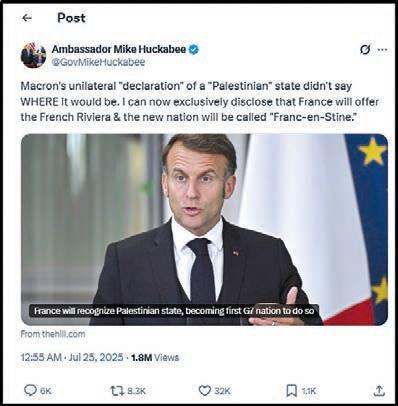


Did you get to see my drive on the first hole? Pretty long! That’s no Joe Biden, let me tell you.
- President Trump talking to the press about his golf outing in Scottland
I’ve stopped six wars…I’m averaging about a war a month.
- President Trump while at a press conference with England’s prime minister
I don’t think anybody wants to hear a lecture … Why shoot for just half an audience? Why not try to get the whole? I like to bring people into the big picture. I don’t understand why you would alienate one particular group — or just don’t do it at all. I’m not saying you have to throw your support [on one side]. But just do what’s funny.
- Former “Tonight Show” host Jay Leno in a recent interview talking about how the current late night hosts are completely politically one-sided and ruining the industry
Rodney Dangerfield and I were friends. I knew Rodney 40 years, and I have no idea if he was a Democrat or Republican. We never discussed politics; we just discussed jokes. I like to think that people come to a comedy show to get away from the pressures of life. I love political humor — don’t get me wrong. But people wind up cozying too much to one side or the other.
– ibid.
The entire European press is singing the president’s praises right now, amazed at the deal he negotiated on behalf of Americans. Tomorrow, the American media will undoubtedly run headlines like “Donald Trump Only Got 99.9 Percent of What He Asked For”
- Tweet by Vice President JD Vance after President Trump signed a new trade deal with the European Union
When I hear my colleagues talk about, you know, the doors of the inn being closed, no room in the inn, I’m saying, you know, I need more people in my district, just for redistricting purposes and those members could clearly fit here.
- A resurfaced video clip from a 2021 House Foreign Affairs Committee briefing in which Democratic Rep. Yvette Clarke, D-N.Y., says the quiet part out loud—the reason the Democrats encouraged an invasion of the country by illegal immigrants was for redistricting purposes, to help Democrats pick up more seats in Congress (although illegals can’t vote, they are counted in the census, which is used for Congressional redistricting)
There’s a lot of great things about California but raising a family is not easy here. Doing business is not easy here.
– California-based In-N-Out Burger chain owner, Lynsi Snyder, disclosing that she and the company headquarters are moving to Tennessee and will seek to expand into markets outside of California
Catlyn Clark had to miss the All-Star game due to an injury. Sports fans, though, say that there are still plenty of good reasons to watch the WNBA; for instance, if someone has a gun to your head.
- Greg Gutfeld, Fox



I’ve been very vocal about the genocide of a generation of women by the cosmeceutical industrial complex, who’ve disfigured themselves.
- Actress Jamie Lee Curtis, 66, in a recent interview disclosing that she is leaving Hollywood because the only way to stay relevant there is by getting plastic surgery, and she refuses to do that
I believe that we have wiped out a generation or two of natural human appearance. The concept that you can alter the way you look through chemicals, surgical procedures, fillers – there’s a disfigurement of generations of predominantly women who are altering their appearances.
- ibid.
All I know is that it is a never-ending cycle. That, I know. Once you start, you can’t stop.
- ibid.
In the now infamous interview making the rounds, Hunter Biden said that illegal immigrants now do all the jobs that nobody wants to do. For example, harvesting, processing, and selling him cocaine.
– Greg Gutfeld, Fox
President Trump said that he plans on going after Obama for ordering the Russian collusion investigation. He claims that the only reason he let Hillary stay out of jail is because he wanted Bill to suffer.
- ibid.
I feel bad for them lowballing Joe Biden on his book, until I remembered— he’s going to sell a ton of these in the middle of the night. Right around 2 a.m., there’s going to be a toilet in Georgia that overflows and then he’s going to sell like 20 million of these things.
- Comedian Michael Loftus on Fox
By Gedaliah Borvick
With Israel’s decisive victory over Iran – even as fighting continues in the south and north – many are asking: what will happen to the real estate market when the fighting ends? Will prices drop? Will the market stagnate? Or will we see the familiar pattern of resilience and growth?
Looking at Israel’s history, a clear trend emerges. While previous wars created short-term uncertainty, Israel’s real estate market has consistently rebounded – often with surprising strength. During and in the immediate aftermath of previous conflicts, domestic and foreign buyers were understandably hesitant to purchase and developers sometimes delayed projects. But these slowdowns were temporary.
After the Yom Kippur War in 1973, Israel’s economy was shaken and inflation surged, but real estate values ultimately climbed. A similar pattern played out during and after the two Intifadas. Although terrorism and instability rocked the country, housing prices held steady and resumed their upward trajectory once tensions eased. The Second Lebanon War in 2006 caused brief jitters in the northern market, yet within a year, prices were rising again. Even during repeated conflicts with Hamas in Gaza over the past two decades, market hesitation has been short-lived. Across much of the country, demand has outpaced supply — and prices have risen.
Soon after the war began on October 7, overseas buyers responded with urgency. After a brief initial lull, sales
in key markets picked up quickly, and prices began to rise. Some are planning long-term for Aliyah. Others are motivated by a deep sense of connection and solidarity. And for others, the motivation is practical: a growing number of Jews around the world want an anchor in Israel – a place of their own, just in case. With antisemitism on the rise globally, the idea of having “a piece of the rock” in Israel has shifted from dream to necessity for many families. It’s not necessarily about moving tomor row – it’s about knowing there’s a home waiting, if and when it’s needed.
Given strong sales over the past 18 months, and clear historical patterns of post-war growth, prices are expected to keep rising.
There are several factors that ex plain why prices tend to rise after wars. Israel’s population continues to grow rapidly, but new housing hasn’t kept pace, creating ongoing pressure on sup ply. Land is limited — especially in cen tral areas — which makes development more difficult and drives competition. And perhaps most importantly, despite the challenges of war, Israel’s economy is widely viewed as resilient and funda mentally strong, giving both local and international buyers confidence in the market’s long-term prospects. Emerging from its war with Iran having restored deterrence and region al standing, Israel’s global business ties are likely to deepen. Countries looking to strengthen security partnerships and tech collaboration may view Israel

as a more attractive partner than ever before. A stronger economy supports a stronger real estate market — particularly in big cities where international business often drives demand.
The October 7 th war is not yet over, but prices in major cities have been rising. If history is any guide, coupled with all the reasons listed above, this conflict’s end will mark the beginning of Israel real estate’s next wave of growth.
Perhaps most importantly, moments of national trauma often ignite renewed commitment. For many, buying a home in Israel is not just a financial decision — it becomes a deeply personal act of connection with Am Yisrael.





Moderated by Jennifer Mann, LCSW of The Navidaters

Love your column! I’ve been dating a girl for a few weeks, and things are going well. The thing is she seems to be more loose with money. She’s a nurse and does well, so I understand that a single girl can get used to these habits. I’m nervous though that when it comes to real life she won’t know how to limit, and I’m not the type of guy that wants to tell his wife what to do or how to spend... But I am worried, that based on her spending, she won’t understand the concept.
Firstly, is this something I should be majorly concerned about? And secondly, when is the best time to bring the topic up and how do I go about this?
Thanks, Dovid*
Disclaimer: This column is not intended to diagnose or otherwise conclude resolutions to any questions. Our intention is not to offer any definitive conclusions to any particular question, rather offer areas of exploration for the author and reader. Due to the nature of the column receiving only a short snapshot of an issue, without the benefit of an actual discussion, the panel’s role is to offer a range of possibilities. We hope to open up meaningful dialogue and individual exploration.

Dear Readers,
We want to offer YOU an opportunity to be part of the discussion! Please email us at MichelleMondShadchan@gmail.com, subject line “reader’s response,” if you would like to participate in the new “A Reader’s Response” columnist spot. We will send you a question and publish your answer in an upcoming Navidaters edition.
If you have a question you would like the Navidaters to answer, please reach out to this email as well.
Looking forward!
Michelle, the “Shadchan”
Rebbetzin Faigie Horowitz, M.S.
Good for you for noticing important differences between the two of you. You say she is “more loose with money.” You also say about yourself that you don’t want to control your spouse’s spending. The answer to your question is that you need to discuss differences and concerns, this one and others.
Families of origin patterns strongly influence young people’s early approach to money and family finances. Keep that in mind when you listen, discuss, and share. How you navigate differences will be important to any couple. Thus, broaching these differences early on is smart and helpful.
The context of bringing this up is not difficult. When you talk about long- and short-term goals for yourself and a family such as security, housing, lifestyle, and community, it’s not going to be a stretch. You can also bring up today’s financial literacy initiatives for young people such as Living Smarter Jewish, Mesilah, and RSK (Reb Shayale’s Kitchen) which offer curricula, counseling, and guidance. In addition, you can also bring up the growing number of podcasts on this topic and ask her what she thinks their popularity reflects about today’s challenges for frum families.
Remember that finances need to be negotiated but it all starts with numbers on paper, facts on the ground, a budget. Budgeting is a skill to be learned, and there are many ways to do it as a couple moves on in life. Awareness, the ability to respect individual styles, and flexibility go a long
way towards achieving goals as a team.
Michelle Mond
Thank you so much for your question!
The good news is that everyone who dates goes through the same (or similar) type of experience. The reason shidduchim is considered “kasheh k’Krias Yam Suf ” is, just as it is seemingly impossible to separate an entire ocean into two (or 12) different parts, it is seemingly impossible for two people with their own personal backgrounds and experiences to decide to come together.
There are so many differences to navigate. Everyone grows up with different ideas surrounding money; it’s the way you discuss it that will make all the difference.
The important thing here is for the two of you to learn to communicate thoughts and concerns in a constructive way.
The girl you are dating is spending her hard-earned money this way right now because she is single and making a nice income. She is taking care of herself in the way she can for the stage of life that she is in. I don’t have to tell you how hard it is to be single when those around you have moved forward. Buying nice things for herself is a way that makes her feel good. Once she gets married and has a family, many things may change. If she is smart and mature, she knows this and understands how important it is to be monetarily responsible.
It is very possible that she acknowledges how her spending habits will ultimately
change at that stage in life. You won’t know this until you talk it out with her directly. Don’t bring up her expensive purchases or habits specifically; rather, talk about the concept and see where it takes you. It is a very normal conversation to have while dating, so it shouldn’t come as a surprise. Obviously, if she gets upset and reactive, hinting to an attitude surrounding money that is unhealthy (such as no concept of budgeting or expectations for constant spending and luxuries), you will know that this is clearly not a match for you.
Hatzlacha!
Dr. Jeffrey Galler
What an amazing, remarkable coincidence!
You cannot realistically expect to find someone who exactly mirrors all of your own opinions.
The very same week that we received your letter, we also received the following letter:
Dear Navidaters, I am a nurse, and for the past three weeks I’ve been dating a wonderful guy. I’m wondering if I have finally met “the right one,” but there is one thing that



bothers me. Whenever I talk about how stressful my job is, and how I periodically enjoy treating myself to a nice meal or a vacation, he looks very uncomfortable.
I understand the importance of proper money management and living within your means, but I worry that he might turn out to be the kind of guy who is very stingy and who just doesn’t know how to enjoy life.
I’m thinking of dropping him. What do you advise?
OK, OK, that nurse’s letter is a fake. We never actually received it. But I made it up because I wanted to share some thoughts with you.
First, you’ve only been dating for a few weeks, and that’s definitely not enough time to get to know someone. You need more time to really understand each other.
Second, there is a big difference between a girl who’s never worked a day in her life and is extravagant with her father’s money, and a hard-working girl who treats herself from her own hardearned salary.
Beware of the high-maintenance Daddy’s girl, because you will spend the rest of your life competing with how her father indulged her. On the other hand, respect the hard-working girl who knows how to balance working hard with enjoying life.
Third, no one wants to marry someone who is either a reckless spender or who is annoyingly stingy. However, it’s completely reasonable that a single, hard-working nurse might want to occasionally reward herself. Similarly, a future husband might want to take a more responsible approach to managing finances.
That said, it’s important to recognize that you cannot realistically expect to find someone who exactly mirrors all of your own opinions. True, there are certain principles that are non-negotiable: Will we be shomrei mitzvos? Do we share the same important goals and aspirations? Can we love, respect, and value each other?
But in the grand scheme of things,
The Navidaters
Dating and Relationship Coaches and Therapists
Hi Dovid,
I really admire how you’re thinking this through. You’re clearly not looking to control or criticize. You’re just noticing something that might matter in the long run, and you’re trying to figure out how to talk about it in a way that’s honest but respectful. That says a lot about the kind of partner you want to be.
If you’re already wondering about long-term compatibility around money, that’s important. It doesn’t mean you’re being judgmental, as much as it means you’re being mindful. People have differ -
ent rela - tionships with money, and those differ - ences don’t have to be deal - breakers. But they do have to be talked about.
I actually think this kind of conversation is best had early on, especially if things are going well and marriage is a realistic outcome. Not because it’s romantic to talk budgets on date four, but because intimacy is built through honesty. If she’s the right one, the conversation will bring you closer, not push you apart.
You might say something like:
most other issues are relatively minor. Successful couples find ways to blend their differing perspectives and learn to compromise on their individual desires.
Moreover, marrying someone slightly different than yourself can lead to a more interesting and, potentially, a more stimulating and happy marriage.
So, take your time and continue dating her. Gently and thoughtfully share your concerns, and you’ll probably find that if you align on core principles, the differences that you’re concerned about can be worked out.
Judith Stark
Dear Dovid, Talk to her.
You’re right to be concerned. Disagreements about finances and spending habits can lead to tension and conflict in a marriage. If you are serious about this girl and are ready to explore the possibility of building a future with her, then yes – this is something the two of you
How you have the hard conversations matters most of all.
will need to discuss.
However, I would advise you to go about this very carefully. This conversation must be approached in a gentle, open-minded, and non-judgmental manner. Your goal should not be to criticize; it should be to open the lines of communication about a potentially sensitive subject, so that the two of you can honestly discuss your needs and attitudes about money.
Realize that this will likely not be a one-time conversation. Like most disagreements, it may take some time to resolve. If you can express your concerns respectfully and accept her feelings calmly, you will strengthen your relationship and make progress towards finding mutually acceptable solutions.
“This feels a little awkward to bring up because I know money is personal, and I wasn’t sure when the right time would be, but I really like you and I’ve been enjoying getting to know you. I also know that in a relationship, shared values around money can really matter, not necessarily doing everything the same way, but being able to talk about it. I’ve noticed I tend to be more cautious with spending, and I was curious about how you think about these things. Is that something you’d be open to talking about?”
That’s not judgment or control. It’s being vulnerable and taking a risk and having the hard conversations I wish all couples would have before marriage.
And the most important thing here isn’t whether she spends too much or not enough; it’s how she responds when you bring something up that matters to you. Does she get defensive? Shut it down? Or does she stay open and curious, even if the topic is hard? And do you do the same?
That’s what you’re learning here. Not just about spending but about partnership. Marriage is a lifetime of conversations; some enjoyable and some difficult. How you have the hard conversations matters most of all. Don’t shy away from it.
Sincerely, Jennifer
By Rabbi Azriel Hauptman
The theory of relativity in its classical sense refers to the famous
tivity as related by our Sages. “Who is rich? He who rejoices in his lot.”



This famous piece of timeless wisdom directs us to look at what we have and

much we have relative to somebody else. Hence, the theory, or more accurately the axiom, of relativity.
At first glance, this should be a fairly easy task. Just don’t care about what other people have, and then you will be happy. Alas, anyone who resides on this planet is well aware of how difficult this can be. When we have less than somebody else, we tend to feel inferior and the feelings of inequity can be very difficult to bear.
This feeling does not emerge in adulthood, rather it is hardwired into our psyche from our earliest ages. When one has a group of three-yearolds, if some of the children receive more stickers, the anguished cries of the “lower-class” children will inevitably resonate through the room.
Researchers even studied monkeys to see how they would respond to inequity. In one study, researchers trained capuchin monkeys to exchange a token for a slice of cucumber. As long as all of the monkeys received the same treat, they all happily and merrily munched on the juicy treat. After some time, they gave some monkeys a sweet delicacy - a grape. The monkeys who were still receiving cucumbers did not take this very well. Some stopped handing in their tokens, others refused to take the cucumbers, and some monkeys even threw the cucumber slices back at the researchers.
neighbors have a nicer house, a fancier kitchen, better vacations, etc.
Studies have also been conducted to see who is happier with their lot in life. Is it the one with the nicest house in the poorest section of town, or is it the one with the least nice house in the most affluent section of town? All of the research has shown that the first person will be much happier, even though the second person’s house is much nicer and grander.
This is also why individuals who feel poor tend to spend a lot more of their money on lottery tickets. Studies have shown that those in the bottom fifth of the income scale spent the most on lottery tickets. Although the chances of winning are basically zero, the emotional difficulties that one has to manage will lead one to grasp for straws and engage in risky behaviors. Critics of the lottery system have even called it the tax on the poor.
What is the solution to this vexing problem? As with many issues that deal with our psychology, part of the problem is that our emotions control us more than our intellect. It is quite easy to understand intellectually that if one has his basic needs met, then what is one missing? However, our emotions get the better of us. For this reason, the more we remind ourselves that our feelings of inferiority are figments of our imagination and are not based in objective reality, the easier it can be.

Imagine if George Washington, who was fabulously wealthy and lived an extremely luxurious lifestyle, would appear in a typical middle-class home today. He would be amazed at the variety of food, the “horseless carriage”, the telephones, the refrigerators, the microwave ovens, etc. He would also be blown away by modern health care. In his time, almost half of the children passed away before the age of five. Don’t even mention air conditioning in the summertime! He would declare, “You are wealthier than the king of England!” Nevertheless, we still have a hard time feeling satisfied when our
We all know that true wealth lies in the intangibles that money cannot buy. Friendships, meaningful relationships, peace of mind, and living our life for a higher purpose. This is your true lot in life from which you can truly rejoice.
This is a service of Relief Resources. Relief is an organization that provides mental health referrals, education, and support to the frum community. Rabbi Yisrael Slansky is director of the Baltimore branch of Relief. He can be contacted at 410-448-8356 or at yslansky@reliefhelp.org
By Reuven Guttman
My wife Esther and I go on vacation every year, usually combining destinations in Europe with Israel and sometimes other parts of the Middle East. However, due to the war at the time of our recent trip, Israel was not an option. We decided instead to take a historical tour—something we truly enjoy, especially when it involves a lot of walking and capturing places of architectural beauty, which Europe offers in abundance.
We hired a phenomenal expert in Eastern European culture and Jewish history: Agnieszka, a professional photographer and film producer who has published several photographic books on Jewish history in Poland.
Upon arriving in Warsaw, Poland, we began at a museum, which led to another museum, and eventually to a hidden synagogue tucked into a residential courtyard. It was still standing—but locked. With a little effort (and some magic), we managed to get inside and take pictures and videos…until we were literally told to leave.
The next day, we traveled to Gdańsk, a beautiful seaside town rich in culture and history, which was actually part of Germany before the war. From there, we went to Łódź, where we visited a magnificent castle that once belonged to a Jewish family and now serves as a museum. We also toured the site of the former ghetto.
In Kraków, the most interesting part of our journey began. Agnieszka, with her vast knowledge of Jewish history, took us to the former home of Sarah Schenirer, founder of the Bais Yaakov movement. To our surprise, the house was under renovation. Undeterred, we went inside and found the apartment, including the original doorframe where the mezuzah had been affixed. Sadly, we also saw other doorposts with clear mezu-
zah indentations that had been removed and brought downstairs—discarded, as though they held no meaning.
Our journey continued to Wrocław, a beautiful city on the Polish-German border, en route to Berlin, where we would spend a few days before flying home to the Five Towns.
Just over the border on the German side—once Polish territory before the war—we came upon a flea market. Something made me stop. My mouth dropped. A vendor had World War II insignias from Germany and Russia, along with a pile of Gemaras and even a cap from a concentration camp prisoner.
Trying to remain calm, I asked the man where he got all of this (as if I didn’t know). He said it had belonged to his grandfather, and he was cleaning out the basement. I started to feel uneasy— thinking about the atrocities committed and why these items were still in his possession.
I asked the price. It was clear he had no idea of their real value. I purchased several items I thought were the most meaningful. When I inquired about the books, he turned to another man who responded in German—language I understand—“Alte Bücher von toten Juden ,” meaning “Old books from dead Jews.”
Little did he know—those were the very items I was determined to take. So that he, and his Nazi-sympathetic grandfather’s legacy, would no longer have them.
Baruch Hashem, I now have them in my possession.
Reuven Guttman is the historian for the Village of Lawrence.


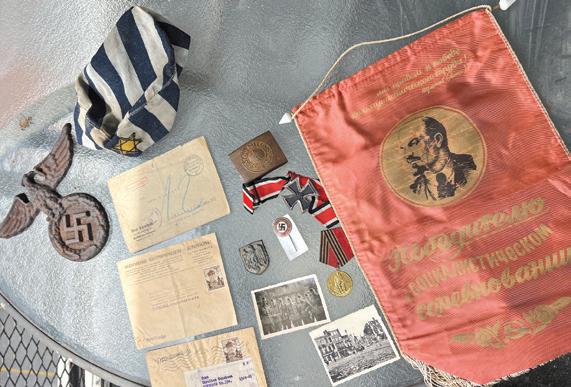
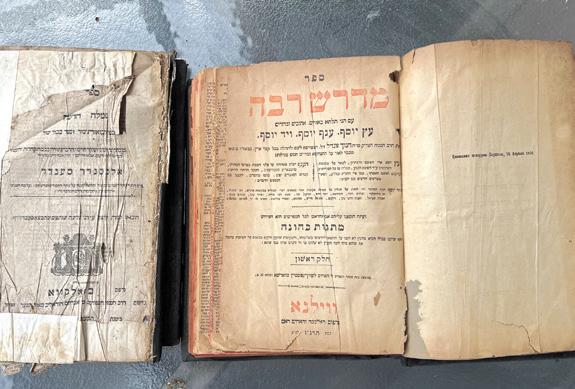
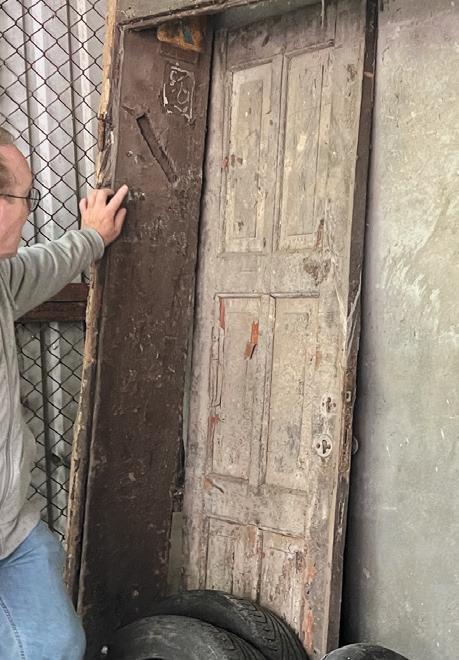

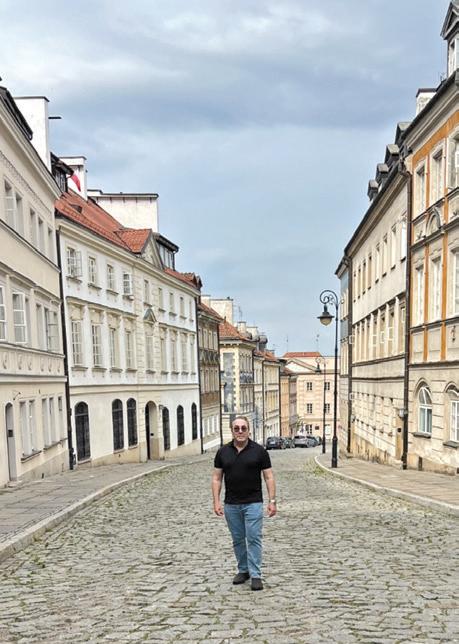
Afrum woman listened sympathetically as her coworker vented about the amount of cooking she was doing to prepare for her family’s Thanksgiving meal. There was a soup course, main, sides and even dessert. She was physically and emotionally overwhelmed. Trying to maintain a neutral face, the frum woman informed her coworker that she did the same thing each week for Shabbos.
Many outside the frum community are often shocked to hear we prepare elaborate multi-course meals each week. The house is cleaned, the kids are dressed in fancy clothes, and we tune out the rest of the world.
This oasis of peace and serenity is a gift each week. In an ever increasingly fast-paced world, we can appreciate the beauty of Shabbos that much more. We are forced to put aside the distractions and focus on those who matter most to us.
Along with this mesmerizing scene comes much planning and preparation. Sadly, the serene picture can turn into screaming, tears and stress. Maintaining the proper pre-Shabbos feeling can
By Sara Rayvych, MSEd

be a weekly challenge, but a little foresight can reduce some of the tension.
The first step to making Shabbos with children is to simplify and prioritize. Rather than try to figure out how to “do it all,” take a few things off the list. It’s far better to have a less fancy menu with simcha than a gourmet meal with stress. My experience is that kids tend to prefer foods they can readily recognize. Often, it’s the items we put the most effort into that kids shy away from. Rather than diminish from the holiness of Shabbos, simplifying is meant to enhance the overall atmosphere and shalom in the home. If parents want to do more in honor of Shabbos, then they should certainly feel free to add in more complicated tasks when the children are older.
Choose easier recipes and make more familiar items – less steps, fewer dirty dishes and increased calm. It’s my personal experience that it’s easier to cook items that don’t require constantly checking a recipe. Alternatively, the more complicated recipes can be
prepared earlier in the week and cooked (or reheated) fresh for Shabbos.
In general, it’s wise to prepare some food in advance. Erev Shabbos is hectic enough, and we want to minimize what needs to be done in those limited hours. Preparing in bulk is often easier than making the same recipe each time. For example, it’s easier to double or triple the chocolate cake recipe and freeze the rest of the cakes for future weeks. Some families have a particular food they enjoy best when it’s prepared just before Shabbos. Preparing everything else earlier in the week leaves extra time for that special dish.
Laundry, cleaning and other preparations can often be done earlier in the week. Yes, the kids will find a way to dirty their clothes or rooms, but it’ll still be less work if it’s just one small load or a quick tidy up.
Shabbos preparations can – and should – be all hands on-deck. Everyone should contribute towards ushering in the Shabbos Malka. Children, espe -
cially, should be added to the roster and given their own age-appropriate tasks. There are many reasons to include the children. One obvious benefit is that we can often use a little extra help. Every small task adds up, and having something taken off your personal list is one less stress. Preschoolers can open tissue boxes or bring them to the bathrooms. Ten-year-olds can vacuum and put away clothes. Teens can cook and do most jobs that an adult can.
We assume certain skills are natural and kids just “pick them up.” It’s surprising how many adults get married and panic when encountering jobs they’ve never done before. Laundry, cleaning, cooking and other daily tasks are not intuitive. Rather than assume they’ll learn simply through existing, we are doing a chessed by actively teaching them how to function in the adult world. Assigning them a Shabbos job provides them with the opportunity to learn an important skill when the pressure is not as intense as it will be in adulthood.
Children should take pride in their accomplishments. When they complete a
task well we should thank them and compliment a job well done. It’s really beautiful to see their young faces shine when they recognize their accomplishments.
Rather than fall into Shabbos, we invest into it each week. The planning and preparations all enhance our value of the day. Our children, too, can benefit from making a weekly Shabbos investment. They can add it to their portfolio.
Children may erroneously think Shabbos just happens to come together each week. The Shabbos Malka just waves her wand, and a full meal appears. Another magic wave, and the table is set. It’s miraculous! Children can better appreciate what goes into enhancing Shabbos when they’ve seen the work happen. Hopefully this will also lead them towards some hakaras hatov for their parents.
Working with children is a skill on its own. They are the sweetest, most adorable crew you will ever work with – but they start off inefficient and, at times, unmotivated. How we handle the situation now is how they will view
these tasks going into the future.
Kids change at a rapid pace, as do their capabilities. We should only assign tasks that are age appropriate and within their current abilities. All tasks should be explained in simple language they can understand, demonstrating when possible. For example, to teach a
only be more likely to gain compliance, we will also maintain a more pleasant environment and demonstrate proper middos.
They will most likely work slower and sloppier the first times they are assigned a given task. It will be easier and quicker to do it yourself – but then
Children, especially, should be added to the roster and given their own age-appropriate tasks.
child how to set the table we might put out all the plates and then demonstrate correct placement of the silverware on one setting.
Often, kids work slower the louder our voice becomes. We can make the same request in a normal volume and precede it with a “please.” We will not
they won’t learn. Educating them will require patience and accepting that jobs may not be completed to our usual standard.
Kids have this tendency of not following through on assigned jobs. It’s important to take a quick peek and ensure they actually did what they were asked.
We can gently and clearly point out any corrections that need to be made. “You did a great job setting the table. You forgot the spoons. I’ll show you where to place them.” We can demonstrate good middos, too, and take the time to thank them and compliment them on a job well done.
Many children, especially teens, prefer being assigned their task earlier in the day. This allows them to work the job into their schedule rather than be pressured on our timetable. “I am giving you a heads-up that your job is to set the table before 4 p.m. Thanks!”
Sadly, in too many homes, Shabbos is ushered in with stress and tension. With some adjustments and siyata dishmaya we can be one step closer to “yom shekulo Shabbos u’menucha .” Have a wonderful Shabbos!
Sara Rayvych, MSEd, has her master’s in general and special education. She has been homeschooling for over 10 years in Far Rockaway. She can be contacted at RayvychHomeschool@gmail.com.

Yehuda

Aryeh & Chana Vegh on the birth of a daughter
Shmuel & Miriam Esther Neuman on the birth of a son







































Note: Not all submission have been published. Keep sending in your artwork for another chance to be featured!
























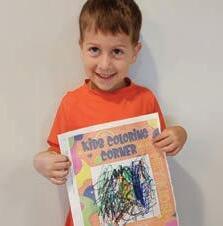
Note: Not all submission have been published. Keep sending in your artwork for another chance to be featured!

By Naomi Nachman
I am writing this recipe which I got from my friend Sara Erlich who made these amazing pancakes when I went to her house in Sydney last week. She had gotten the recipe from Once Upon A Chef and made her own tweaks. She has also made them parve by omitting the butter and switching milk to almond milk. These pancakes were absolutely amazing and so light and fluffy.

◦ 2 cups all-purpose flour
◦ 4 teaspoons baking powder
◦ ¼ cup sugar
◦ 1 teaspoon salt
◦ 2 large eggs
◦ 1 teaspoon vanilla extract
◦ 1½ cups milk, plus more if necessary
◦ 4 tablespoons unsalted butter, melted and slightly cooled, plus more for cooking
◦ Canola oil, for cooking
1. In a large bowl, whisk together the flour, baking powder, sugar and salt
2. In a medium bowl, whisk the eggs, vanilla and milk until evenly combined
3. Pour the milk/egg mixture and the melted butter into the dry ingredients and whisk until just combined. If the batter seems too thick, add 1 to 2 tablespoons more milk.
4. Heat a nonstick pan over medium heat; coat it lightly with oil and swirl in a thin pat of butter.
5. Ladle or drop the batter into the pan, using approximately ¼ cup for each pancake; cook until the first side is golden brown, or until the top surface bubbles and is dotted with holes. Flip and cook until the other side is golden brown. This happens quickly so peek after 30 seconds and watch carefully! Adjust the heat setting if necessary. Wipe the griddle clean with a paper towel between batches.
6. Serve immediately with maple syrup.
Naomi Nachman, the owner of The Aussie Gourmet, caters weekly and Shabbat/ Yom Tov meals for families and individuals within The Five Towns and neighboring communities, with a specialty in Pesach catering. Naomi is a contributing editor to this paper and also produces and hosts her own weekly radio show on the Nachum Segal Network stream called “A Table for Two with Naomi Nachman.” Naomi gives cooking presentations for organizations and private groups throughout the New York/New Jersey Metropolitan area. In addition, Naomi has been a guest host on the QVC TV network and has been featured in cookbooks, magazines as well as other media covering topics related to cuisine preparation and personal chefs. To obtain additional recipes, join The Aussie Gourmet on Facebook or visit Naomi’s blog. Naomi can be reached through her website, www.theaussiegourmet.com or at (516) 295-9669.


